









Food is our most basic, primal desire. Even before our need for shelter or our desire to procreate, food comes first. The recipes for the food we talk about in Whole Food Living are based on solid scientific research and clinical experience over the past 50 years.
Legumes
Whole grains & starches
Vegetables
Fruits, nuts & seeds
Herbs & spices
Oils, sugar, salt
Heavily processed foods

Eggs & dairy products
Seafood
Meat & poultry
Our health, good or bad, is the result of the food we eat. There are genetic and environmental conditions that can affect our good health but for most of us, our health is determined by what we put on our plates. For this magazine, food and optimal health is our primary focus.
The third and final factor in the whole food equation is environment. Why? Because the state of our environment is impacted by the food choices we make. Understanding the connection between food, health and environment is key to developing a more sustainable world.

The WFL Optimal Health Guide is a simplified, visual explanation of different eating styles.
Our policy is to assist and encourage plant-based eating and to explain the significant health benefits available to those that become fully whole food plant-based.
WFPB eating is comprised of foods drawn solely from the first five categories on the table.
Strictly speaking, sugar, oil and salt are off the menu for people who are fully WFPB based, especially those who have experienced serious medical events.
We place sugar, oil and salt along with highly processed foods in the Avoid category as a warning because, unless you prepare everything you eat at home yourself, you are unlikely to achieve a perfect score.
In your quest towards better eating, don't let perfect become the enemy of good.


Critical contents of this magazine, particularly articles that cover medical issues, are referred to our editorial consultants.
It is not intended to be a substitute for professional medical advice, diagnosis, or treatment. Please seek medical advice before using diet to treat disease.
Our consultants are:
* Dr Mark Craig
* Dr Caitlin Randles
* Dr Martyn Williamson
The medical and/or nutritional information covered in Whole Food Living magazine is for educational purposes only.Vegetarian Vegan Plant based WFPB
I’d like to think there’s something significantly different about every issue we produce but this time, I believe, we’ve really hit the spot. It’s a good issue for me because, after almost five years of changing to a Whole Food Plant based-diet, I’m coming to grips with issues I haven't faced down before.
One of these is the subject of reductionism and reductionist thinking and how it impacts our understanding of health, particularly where supplements are concerned. If we’re taken in by its advertising we’re led to believe that many worthwhile benefits are to be had if you just keep swallowing their capsules.
Maybe I’ve been a bit too ambivalent about supplements because, when I took statins after my stroke, I was told that CoQ10 would be a big help in managing the muscle aches often associated with statin use – and it did. The problem was the cost and the way its availability was managed.
The chemist shop I bought from regularly ran half-price specials on the product which would cost $60 one week but only $30 a few days later. Once, when we were particularly tight for cash, I went in only to be told that I should have come in a couple of days earlier when the half-price offer was running. The woman behind the counter insisted on the $60 price so I’ve probably had a negative attitude towards chemist shops ever since.
To be fair though, having seen the medications my mother took over the last days of her life, I think I developed an aversion to pills from childhood. So, if you’ve read it already, you can well imagine why T Collin Campbell’s book Whole was such an eye-opening read over the last few weeks.
Campbell talks about a reductionist approach to nutrition and I take a tilt at explaining this in an article on p42. It’s a fascinating subject but one which I still find a level of confusion surrounds, even amongst some long-term WFPB advocates.
For me, if supplements are generally not a good idea, how
come I’m taking vitamin B12 every day? And yes, I understand the discussion about what’s not available in the soil these days and the fact that its injected into animals and added to my plant milk but, if B12, zinc tablets, vitamin D and even iron supplementation are acceptable, does that mean all other supplements are absolutely useless? I still have questions at times and, as I conclude on p47, where WFPB is concerned, I can only ever be a work in progress.
Something else I’ve had my eyes opened to over these past weeks is a ‘new’ brand of eaters called reducetarians. I’d heard of pescatarians but the term reducetarian was new to me and made me think - is a pescatarian also a reducetarian and does it matter? You can see why I sometimes struggle to sleep well. Apparently, a reducetarian is someone who still eats some animal products but works on reducing them. That’s surely a good thing because it can only mean eating more plants, but we're wary of it for anyone with a diagnosed lifestyle condition of the type Dr Ralph Koelmeyer describes on p19.
The Reducetarian Foundation is based in Los Angeles, California, where its founder Brian Kateman works hard to further its cause. His efforts were recognised with an article in Time magazine in June last year so reducetarianism, I’ve concluded, must be a thing. I only wish we could hear more about it in the southern hemisphere.
Our discussion with Dr Darren Morton and the resulting article on p10 is this issue's absolute bonus. Morton is not only an expert in the field of Lifestyle Medicine, he's also internationally recognised as one of its foremost exponents.
He passionately encourages us to take charge of our health and has real concern that health systems look set to be overwhelmed. He plumbs the deeper meaning of wellness and points out why our good health is much more than a medical solution. If that thought arouses your curiosity then turn to the centrespread (3435) where we explore the meaning of awe.
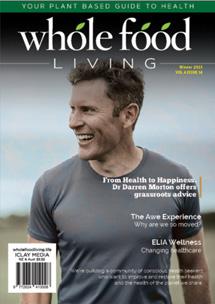
Whole Food Living (ISSN 2624-4101Print. ISSN 2703-4313 - Digital, is subject to copyright in its entirety. The views expressed in this publication are those of the contributors and not necessarily those of Iclay Media.
No responsibility will be accepted for unsolicited material. No liability is accepted by Iclay Media, the publisher, nor the authors for information contained in this magazine.
Every effort is made to ensure the accuracy and veracity of all content in this publication but neither Whole Food Living nor its publisher Iclay Media is responsible for damage or harm of whatever description resulting from persons using any advice, consuming any product or using any services in Whole Food Living's print, electronic publication or website.
Contact us 67 Kayes Road, Pukekohe, Auckland, New Zealand 2120 p. (Peter) +64 27 218 5948 e. editor@wholefoodliving.life w. www.wholefoodliving.life
Editor: Peter Barclay

e: peter@wholefoodliving.life
Food Editor: Catherine Barclay, e: catherine@wholefoodliving.life
Printer: Inkwise, Christchurch
Distributors: Are Direct, NZ Post & Iclay Media
Contributions & Assistance
Contributions & assistance on this issue is gratefully acknowledged from the following: Innes Hope, Janice Carter, Karen Crowley, Dr Mark Craig, Dr Martyn Williamson, Dr Darren Morton, Nicole Morgan, Dr Ralph Koelmeyer, Silva Mirovics, Stephanie Manzinali, Jessica Lamb, Polly Baptist.
General Features
10. Lifestyle Medicine
Dr Darren Morton dives into the details on what makes it such a grassroots effort.

14. ELIA - healing & hope
Lifestyle Meicine Coach, Janice Carter, explains what ELIA is all about.
18. Food prescriptions
Dr Koelmeyer unveils what ailments they can help.
22. Building a better brain
Silva Mirovics - walking your brain to better health.
Innes Hope outlines some of the steps that count.
30. Fasting for chemo
Does it produce a better outcome for patients? Dr Greger reviews.
34. The awe experience
It happens almost everywhere according to Dacher Keltner. But what moves you?
38. Camouflage & mice
How fake news baffles both humans and rodents alike.
42. Reductionism
It now rules science and the whole of healthcare.

The AA experience has some interesting comparisons.
50. Diverticulitis
What causes diverticulitis and does more fibre help this gut issue?
56. Brewed meat burgers
Can they help save the planet or will rampant commercialism finally face the yuk factor?

Many of the articles published in this magazine refer to scientific studies. To view these studies use the QR code or go to the url below.
Click or scan QR image for references.

28
Recipes
13.
"It's really hard to follow through on healthy lifestyle behaviours if your mental health is suffering."
- Dr Darren Morten
"The deep desire of every human is to be healthy but more often than not, we just don't know where to start."
- Janice Carter

33.
Inject more nutirents into your life. Some incredible combos in this must-try dish.

17. Tofu Mac & Cheese
Another well tried and tested Janice Carter creation. Great twist on a traditional dish.
21. Mozzarella sticks
Vegan babe Stephanie Manzinall does yum so well!
27. Turmeric cauliflower
An exquisite creation. A whole healthy dish of sheer delight.
32.
A traditional European creation that goes back yonks.
This low-fat plant-based filling contains hummus with cumin and a great cheesy flavour .
34. Chilli tofu larb
A spicy Thai larb as you have never tasted before. Another Nicole Morgan creation.

37. Tofu crustless quiche
Super easy, and definitely a crowd pleaser this one.
45. Butterbean casserole
Butterbean, potato & mushroom casserole delight.
Three taste tempting dressings you'll want to try.
Our little steps do add up. This gives me hope, and the strength to carry on."
- Innes Hope
"Awe is almost always nearby, and is a pathway to healing and growing in the face of the losses and traumas that are part of life."
- Dr Dacher Keltner

A former Olympian and now is co-founder and chairman of The Plantrician Project and Regenerative Health Institute amounst numerous other organisations.

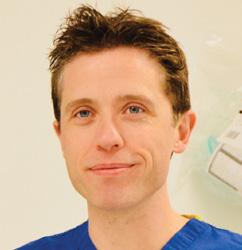
Founder of NutritionalFacts.org
a significant resource in both videos and researched writings on the benefits of eating Whole Food Plant-based.
Has a special interest in holistic health, plant based nutrition and lifestyle medicine. Is a senior partner in a UK family medical practice where she worked for 12 years.


An American cardiologist and currently head of a Chicago medical centre. Vocal on the benefits of plantbased nutrition to cardiovascular health.



Founder and director of Plant Based Health Professionals UK. An honorary senior lecturer at King's College Hospital London. Passionate about plant-based nutrition.
Gifted speaker on plant-based nutrition. Teaches other health care professions on the importance of nutrition in clinical practice and integrative medicine

An Australian doctor based at Loma Linda California. Passionate in empowering people to optimise their health through improving life-style choices with evidence based eating
Founder of Physicians
Committee for Responsible Medicine and a very active member of the WFPB Community.
A biochemist and author of The China Study. He coined the term Whole Food Plant-Based, at age 86 he is still regularly speaking at plant based events.




A chiropractor and founder of the TrueNorth Health Centre based in California. Co-author of best selling book, The Pleasure Trap. An expert in fasting for health.
Author of Prevent & Reverse Heart Disease. Former Olympic athlete now directs the Cleveland Clinic Wellness Institute.

Diagnosed with Multiple Sclerosis Dr Saray created a movie called Cold Blue showing her wellness journey through adoption of lifestyle medicine.
A registered medical doctor and author based in India, Founder of SHARAN and recipient of Nari Shakti Award for her pioneering work in the field of health and nutrition.


Dedicated to helping people transition to a WFPB Diet. Runs 10 day retreats for people making the transition to a plantbased diet.
Leads a Gastroenterology clinic in Torbay, South Devon UK. Advises plant-based dietary treatment for many chronic digestive disorders.
Founder of the nonprofit Preventive Medicine Research institute, California. Creator of the Ornish program for Reversing Heart disease.

Founders of Team Sherzai, this couple are dedicated to educating people on simple steps to long-term health and wellbeing through their work as co-directors of the Alzheimer's Prevention Program at Loma Linda University in America. They work to demystify the steps to achieving long-term brain health and the prevention of devastating diseases like Alzheimer's and dementia.

 Dr Scott Stoll
Dr Kim A. Williams
Dr Shireen Kassam
Dr Renae Thomas
Dr Michael Greger
Dr T Colin Campbell
Dr Alan Goldhamer
Dr Caldwell Esselstyn
Dr Saray Stancic
Dr Nandita Shah
Dr Neal Barnard
Dr John McDougall
Dr Alan Desmond
Dr Dean Ornish
Drs Dean and Ayesha Sherzai
Dr Gemma Newman
Dr Michael Klapper
Dr Scott Stoll
Dr Kim A. Williams
Dr Shireen Kassam
Dr Renae Thomas
Dr Michael Greger
Dr T Colin Campbell
Dr Alan Goldhamer
Dr Caldwell Esselstyn
Dr Saray Stancic
Dr Nandita Shah
Dr Neal Barnard
Dr John McDougall
Dr Alan Desmond
Dr Dean Ornish
Drs Dean and Ayesha Sherzai
Dr Gemma Newman
Dr Michael Klapper
A lifestyle medicine and General Practitioner in Ponsonby, Auckland, NZ. Founder of TrueSouth Medical and founding member and deputy chair of EBE.NZ

A clinical Pharmacist and founder of The Better Base in Nelson NZ. She has an eCornell Cert. in Plant-Based Nutrition.
A Paediatrician and Co-.Founder and chairman of Doctors for Nutrition. Based in Teringie, South Australia
A GP in Wellington NZ. Co-Founder of Two Zesty Bananas, Board Director of Doctors for Nutrition and co-author of the BROAD study.
A GP in Mt Maunganui, NZ. An advocate of preventative medicine and lives a plant-based lifestyle with her physio husband Brad and their two daughters.
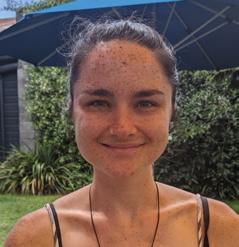
An exercise physiologist, sports scientist, diabetes educator based in Australia who is healthy and thriving with type 1 diabetes.
A registered nurse in Nelson, holds a certificate in plantbased nutrition. She leads workshops and retreats and focuses on helping women to improve their holistic wellbeing.

A GP in Alexandra NZ. Co-Founder of Plant Strong Living, Founding board member of EBE.NZ and Central Otago Health Services Ltd.


A Naturopath, counsellor, EFT therapist and Lifestyle Medicine Practitioner, Founder of Empower Total Health, Australia. Based in Robina, Gold Coast.
A rural General Practitioner in South Australia. He is a fellow of ASLM, and a Ambassadoc for Doctors for Nutrition. He counsels and educates on healthy living.
Based in Invercargill Dr Joseph is possibly the world's most southern WFPB GP. He regularly conducts plant-based retreats for people in his local area and has joined the EBE exec.



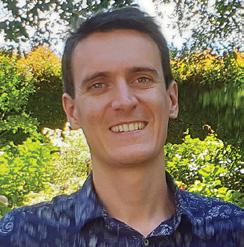

Is the principal psychologist in the Highlands Recovery Support Centre based in Bowral NSW, he is focused on helping people adopt a healthier food lifestyle.




An Australian practising Dietitian and Nutritionist. Founder of Greenstuff Nutrition. The Queensland Lead Dietitian for Doctors for Nutrition.



A General Practitioner based in Gisborne. Co-Founder of Plantbasedvideos with his partner Morgen Smith. Co-Author of The BROAD study.
A British General Practitioner based in Auckland. NZ. Passionate about educating on Whole Food Plant-based living.
A General Practitioner based in Melbourne Australia. Co-Founder of Plant Based Health Australia. He is Resources Advisor for Doctors for Nutrition.


An Accredited practising dietitian, lifestyle medicine practitioner & wellness coach based in Melbourne. Masters in Nutrition & Dietetics & a PHD in Human Genetics.
A General Practitioner based Tasman. Is passionate about preventative medicine, promoting wellness by addressing the common underlying causes.
Dr Mark Craig Dr Heleen RoexHaitjema Dr Luke Wilson Dr Coral Dixon Drew Harrisberg Hannah Barnes Hannah O'Malley Dr Martyn Williamson Robyn Chuter Dr Adrian Griscti Gerald Haslinger Emma Strutt Dr Nick Wright Dr Caitlin Randles Dr Malcolm MacKay Dr Peter Johnston Dr Wayne Hurlow Dr Thomas JosephSydney based Lifestyle Medicine expert, Professor Darren Morton, discovered early in his professional career that there was a lot more to health than what many of his colleagues were initially taught to believe. His own journey started from a physical exercise background but the road soon took a turn.
“I was trained as a physical education and maths teacher. Very quickly though, I went on to further my studies in human physiology which focuses on how we humans are put together and how we work.”
He always had a special interest in exercise physiology and was very passionate about encouraging people to move more and live more actively. But, then, “I had this epiphany over 20 years ago now.”
“It dawned on me that my key interest was helping people to live healthier so they could be happier. In so doing, people feel more empowered to make the contribution they’re meant to make in the world.”
For Dr Darren, as he is more commonly addressed by those involved with him, Lifestyle Medicine was a natural progression. He’s still very passionate about exercise and views it as one of the pillars of good health but there are several others as well. “Clearly nutrition—what you eat and what you don’t eat—is a really important part of that,” he says.
For 30 years Dr Darren has been based at Sydney’s Avondale University where he is the Director of the Lifestyle Medicine and Health Research Centre. It’s all been a natural progression but, when asked why many other doctors don’t make the same broad connection, he says it’s easy to become quite sceptical.
“There are forces that conspire against this and some of them are quite sinister. At the heart of it a lot of people get taken along with that momentum and there’s just a lack of awareness of the alternatives,” he says.
“I think, for example, when we look at medical doctors, what they are trained in is not a lifestyle paradigm. And, you can sort of understand how it happens.
“Modern medicine earned its stripes in a time when infectious diseases were the biggest burden of disease. We developed some really clever technologies, such as antibiotics and other medicines, that were very effective in dealing with infectious diseases. But we’ve become very reliant upon those medications and pills as the medical approach became predicated on them.
“One of my good friends and mentors, Dr Hans Diehl, says for every ill there’s a pill, and for every pill, there’s a bill. Hence. you can understand how the whole economic wheel starts to revolve around pharmacology.
"As chronic diseases have taken over in the past few decades
as the main cause of mortality and morbidity, modern medicine has endeavoured to apply that same paradigm that worked for infectious diseases—pills and medications. Of course, there are medications that have some value for the management of chronic disease, but we have failed to see the glaringly obvious - that chronic diseases are lifestyle-related illnesses. Hence, the best treatment for chronic disease is lifestyle modification—we need to treat the cause.
"That is what lies at the heart of Lifestyle Medicine—to look upstream at the cause of chronic disease and treat them. Any approach to the management and treatment of chronic disease that does not prioritise lifestyle modification is founded on an erroneous paradigm.
“One of my concerns with nutrition research is that it has become so reductionistic. Researchers are always on the hunt for some magic ingredient in foods. It is not enough to observe that blueberries are health-giving, researchers want to discover if there is a magic ingredient in blueberries that can be extracted and marketed as the next great panacea and cure-all for all ills.
"But the truth is that there is no one magic ingredient in blueberries, there are a myriad of nutrients in blueberries that work synergistically to make them so life-giving. The simple takeaway is blueberries are good for us and we should eat them.
These days, Dr Morton says, most of his time is focused on mental health and wellbeing.
“The reason I have taken so much interest in that area is because we talk about behaviour change and we try and get people to eat healthier and lose weight and the like, but people often don’t do that because they’re not in a good place emotionally.
“It’s really hard to follow through on healthy lifestyle behaviours if your mental health is suffering. Indeed, there is a reciprocal relationship between how you feel and how you behave, and how you behave and how you feel.
“Applying a whole-of-health approach is absolutely critical to the pursuit of total wellbeing. For example, whole-food plantbased eating is a fantastic pathway to health and happiness— there is so much science that demonstrates this—but you can be meticulous with your diet and still be absolutely miserable. Similarly, you can be a highly active person and still not be full of the joy of living.
"To me, wellbeing is much more than just what we eat and how we move. Well-being is about feeling good and feeling good about life. In truth, eating well and moving well are pathways to feeling better, but to feel better about life we have to take that deeper dive into spiritual questions. Of course, that means
"You can actually be meticulous with your diet and still be absolutely miserable. And you can be a highly active person and still not be full of the joy of living. The bigger goal here is what I would refer to as wellbeing."
different things for different people, but at the heart of it what people need, I believe, is a sense of why.
“People are looking for meaning, they’re looking for purpose. They need to know that they matter and that this life matters. During Covid, many people encountered an existential crisis. Modern living is so busy nowadays, but Covid was a time when many of us were forced to slow down, which gave us time to reflect on bigger existential questions.
“My experience is that that needs to be part of the dialogue. It needs to be part of what we address when we look at wholistic wellbeing. Eating healthy, moving well and getting good rest are really important pillars of good health, but without addressing what makes life really worth living we don’t set ourselves up for the fullest expression of what wellbeing might be and can be.”
Do you think the health system would be improved if people took better care of themselves?
“This is foundational to Lifestyle Medicine which teaches that we are in the driving seat of our health and wellbeing. The current healthcare system applies an ‘expert’ model whereby the doctor is the expert, they tell us what to do and we’re meant to do it (and of course, we don’t for the most part). Essentially, our health is in their charge and their control.
“But nothing could be further from the truth. Our decisions and behaviours make a huge contribution to our health and wellbeing.
"Look at the information coming out of some of the large European studies like EPIC (European Prospective Investigation into Cancer). We know that just four basic lifestyle choices— eating a healthy diet, being active, controlling your body weight and not smoking—reduces your risk of heart attack by 80 per cent, type 2 diabetes by over 90 per cent and stroke by 50 per cent.
“This is huge! There are no medicines that can do that. Lifestyle is incredibly powerful and effective.
“Now it’s easy to recite statistics but imagine, if through proper education and the right kind of support, people were
empowered to make better lifestyle choices resulting in 8 out of 10 fatal heart attacks not occurring, or 9 out of 10 cases of type 2 diabetes not occurring. That would change the entire healthcare landscape. We need to get better at understanding that people can take charge of their health and provide them with the support to do so. People need to know that there is hope.
“What I love about Lifestyle Medicine is that it is helpful for not only preventing chronic conditions, it can also be effective for managing, treating and even reversing them.

“In 2018, the Lancet published a paper saying that through therapeutic lifestyle change up to 50 per cent of diabetes can be reversed – even for people who have had type 2 diabetes for a number of years. This is a game-changer.
“Lifestyle Medicine is one of the fastest growing disciplines in health care around the world, but it still has so far to go. It will get there eventually but it’s just going to take time. That paradigm shift will occur bit by bit.”
Dr Morton says critical support for Lifestyle Medicine is coming from the grassroots.
“It’s so powerful when you have credible sources,” he says, “people who say, ‘this is what it has done for me’. That connects with people.
“When it comes to behaviour change, credible sources are far more influential than incredible sources. For example, when a dietitian who is a little overweight themselves and struggles with their weight says to a client, I used to be a size 20 and it has been hard but I am now a size 14 and if I can do it, so can you, it is very compelling. They are relatable and credible, even more so than someone who is very lean and tries to counsel them on weight loss (i.e. an ‘incredible source’).
“When it comes to Lifestyle Medicine, we can all be part of it. We are all on a wellness journey and we all have a story to tell. Sharing stories, especially of personal transformation, is incredibly powerful for helping other people to embrace that same journey.”

This incrediable combinationis a must to try - I am always looking to get more nutrients out of the plants I eat ! by Polly Baptist | Instagram @pollybaptist | serves 4
1/2 red cabbage
1/2 white cabbage
2 tbsp olive oil
salt
pepper
Cabbage toppings
300g brussel sprouts - shaved using a mandolin
1/2 cup sunflower seeds toasted
1/4 cup chopped toasted walnuts
2 tbsp sesame seeds
Chilli oil (optional)
1/3 cup neutral oil - peanut / grapeseed
4 cloves of garlic chopped finely
2 red chillies chopped finely
1 tsp dried chilli flakes
1/2 tsp paprika
Miso sauce
150ml tamari
2 tbsp shiro miso or chickpea miso
1.5 tbsp grated ginger
1 tbsp maple syrup
1 large garlic clove grated
Coconut tahini sauce
1/2 cup coconut yogurt - Cocobello
2 tbsp hulled tahini
1 clove garlic
1 tsp maple syrup
1/2 cup coriander leaves
1/2 cup parsley leaves
2 sprigs of mint leaves
1. Preheat the oven to gas mark 6 / 200°C / 400°F Line a baking tray with baking paper large enough to hold cabbage slices
2. Cabbage - Cut the cabbage pieces into 1/4s and place them on the baking tray then drizzle on some oil or water, and season with salt and pepper before placing in the oven for 30 mins uncovered. After this time turn them over and place them back in the oven for another 30 mins lightly covered with some aluminum foil.
3. Miso dressing - Whilst the cabbage is cooking mix together the ingredients for the miso dressing. I prefer shiro or chickpea miso but if you prefer a stronger flavor use a brown rice miso or red miso.
4. Mix everything with a whisk and then place the lid on the jar and shake, you can always make double the amount and use this dressing with a stir fry
or with other roasted vegetables such as brussel sprouts, carrots, beans etc.
5. After the cabbage has been in the oven for an hour remove it and pour over the miso sauce making sure the sauce goes in-between the leaves of the cabbage wedges. I might open a few up to allow more of the sauce to pour into the leaves. Place the cabbage back in the oven uncovered for a further 20 mins, using a toothpick to check if the stems of the cabbage are soft and cooked.
6. Coconut tahini dressing - Place all the ingredients for the coconut tahini sauce into a high speed blender and blend until the leaves of the herbs are cut up finely and the sauce turns a bright green. Taste and season accordingly. Place in a jar and let it rest in the fridge whilst you finish preparing the dish. Any extra is always great to dress a salad or buddha bowl. If you notice the dressing is to thick to pour just slowly add tbsp at a time some filtered water, and mix until you get the right consistency.
7. Chilli oil (optional) - Place all the ingredients except the neutral oil, into a heat proof bowl. Heat the neutral oil up to a high heat and pour over all the other ingredients and allow to cool down. This can be stored in a glass jar and any extra used on pasta or rice dishes, over roasted or steamed vegetables such as broccoli, or bok choy.
8. Brussel sprouts - Gently pan fry the brussel sprouts, tossing regularly so they do not burn, but until lightly caramelized.
9. Place the cabbage wedges onto the centre of the plate one white wedge and one red wedge, place some of the shaved brussel sprouts over the top, pour around the coconut tahini herb sauce and some chilli oil before sprinkling over some of the toasted seeds. Serve with some lime tamari black rice.
Some of the health benefits from this recipes it contains 16 different plants allowing us to eat a large amount of fibre that our microbiome will benefit from and in turn our overall health will thank us for. It is full of antioxidants, good fats, ferments from the miso and tamari, and anti inflammatory properties and add a burst of umami flavours in the different elements in the dish. By using red cabbage and white cabbage we can benefit from different compounds found in the cabbages as they are different colours and regardless of what vegetable you have such as onions, cabbage, cauliflower or red and green apples, different coloured plums, it means that the more different colours you use the more varied the nutrients you gain.

We need more centres such as this throughout New Zealand and Australia. Imagine the impact on society. Personal health would be greatly improved, and the debt burden to support healthcare would reduce dramatically.

The ELIA Wellness Summit, held in Sydney in March, was so impactful that I've truly struggled to find words to describe this increcible event. The passionate, gifted and talented summit keynote speakers, all experts in their Lifestyle Medicine fields, inspired and motivated all 200-plus attendees with excellent presentations containing a wealth of information.
Overall, a truly memorable event and to top it off, its wholefood plant-based meals were inspiringly creative and delicious. ELIA Wellness is a health promotion charity that empowers people to whole-person health.
“When people think about health, they often think about physical health, which is of course important, however, wellness
is so much more than this,” executive director, Dr Geraldine Przybylko, told those gathered.
“For example, if we are only focused on being physically energised and not socially connected or emotionally thriving, it may lead to unsatisfying relationships and poor mental health. We value the importance of whole-person health and investing in each of the seven dimensions (see below) to achieve optimal health. Our goal is to support you on your journey to wholeperson health so you can live your best life”.
ELIA partners with expert health professionals providing evidence-based resources to help manage and prevent disease. These resources are available at your fingertips through an app. The app provides sound, evidence-based advice, through
face-to-face and online programmes. Used regularly, it will help bring health, healing and hope to you, your family and your community.
My experience with ELIA has shown me that, with the support of its advocates and facilitated programmes, improving your health in a well-rounded holistic way is much more doable. In short, it’s now easier than ever to take charge of your health.
Doctors’ visits for illness have become a non-event in our household since adopting a whole food plant-based lifestyle. This can only be a good thing. The snowball effect of the debt burden on our countries’ health systems proves that programmes like ELIA are urgently needed.
ELIA stands for Empower Lifestyle Innovation Advocates. It is designed to empower the community to improve its health outcomes. This is done by targeting 7 Dimensions of Wellness. These are:
1. Physically Energised: Eating and drinking well, moving, resting and sleeping well
2. Emotionally Thriving: Having a positive mindset and outlook, emotional intelligence
3. Environmentally Attuned: Living in an uplifting physical environment
4. Intellectually Engaged: Keeping the mind healthy through learning and thinking
5. Socially Connected: Through a social network, engagement and relationships
6. Spiritually Empowered: Having hope, gratitude, purpose and meaning in life
7. Vocationally Enriched: Serving others with kindness and compassion
Under the platform of ELIA Wellness, the mission is to educate and empower the community by providing user-friendly programmes that help people transition to a whole health experience. The deep desire of every human is to be healthy but more often than not, we just don’t know where to start.
By using the 7 Dimensions of Wellness, you can check in with yourself as to how you are doing in each category. From there, you can plug into one of its many wonderful programmes to start your wellness journey.
For me, using the app has been motivating and selfempowering. I'm more accountable to myself for my daily actions; to think more about what I am doing and be more mindful.
When you create a free ELIA Wellness Member account you will receive:
• Free access to 100 plus whole-person health articles and videos
• Free access to 30 ELIA Fitness workouts online
• Free 30-day Reduce Your Risk of Cancer plan
• Free access to healthy plant-based recipes
• Access to evidence-based whole-person health online courses, and more.
Some examples of evidence-based whole-person health programs available through ELIA Wellness are:
Enhance Your Gut Health
This section takes you on a journey toward a healthier microbiome. Brought to you by experts in the field of nutrition and Lifestyle Medicine, this programme teaches you strategies that aimed at helping you to achieve more balanced gut health, reduce your risk of disease and improve your quality of life. Learn how caring for your gut could give you a new lease on life!
Here you develop emotional intelligence and resilience so you can buffer the stresses of life. It offers simple solutions for
complex problems and shares principles and skills applicable to most stressful situations. Why do so many people feel so stressed? Learn what is triggering your stress and how to activate the relaxation response.
This carefully designed guide enables you on a journey of personal growth and transformation. Its aim is to empower you to strive for success and experience the joy and happiness that comes with accomplishing your goals and fulfilling your purpose in life.
The Live More Project
Live More brings together scientifically-proven strategies from Neuroscience, Psychology and Lifestyle Medicine into a fun, experiential and life-enhancing programme. Developed and presented by Dr Darren Morton, the Live More Project is helping people improve their health and happiness around the world.
Retirement Ready offers a personal and practical guide to making the most of the exciting opportunities of retirement and meeting its inevitable challenges. While life is uncertain, planning for this stage of life gives the best possibilities for living well in retirement.
Everyone has a story. Nobody can go back and start a new beginning, but anybody can start today and make a new tomorrow. Forgive to Live can help you start a better journey. In conjunction with Florida Hospital and the Stanford University School of Medicine, Dr Dick Tibbits conducted a study of how anger and forgiveness affect health. The findings of this study became the Forgive to Live programme.
In partnership with the leading Sydney Adventist Hospital Integrated Cancer Centre, this four-week programme helps to educate and empower participants to adopt a healthier lifestyle to reduce their risk of cancer. Here you’ll find daily short videos and easy-to-do activities that will make a real difference in your life.
This section includes wonderful, easy, everyday whole food plant-based recipes. The app will help you track where you are going and help you stay on the wagon. And, of course, if you fall off the wagon, which we all invariably do at times, the Wellness app helps you get back on track and feel good about your journey without beating yourself up.
From what I have seen and experienced in becoming an ELIA Wellness advocate, there is no other programme like it that I am aware of. Its a complete package, well thought out and beautifully put together.
ELIA also offers free, online training for health enthusiasts who are passionate about promoting health to their community. You can become an ELIA Partner and learn how to run and lead community groups using ELIA’s health resources.
As part of the summit, one of the big highlights for me was attending the opening of the new ELIA Lifestyle Medicine Centre at the Sydney Adventist Hospital, in Wahroonga.
The mission of this newly opened centre is to transform healthcare by providing evidence-based Lifestyle Medicine consultations, programs and interventions that address the root causes of chronic illness or disease.
The ELIA Lifestyle Medicine Centre interdisciplinary team include lifestyle medicine doctors, registered nurses, health coaches, exercise physiologists, dieticians and psychological care to help support and coach patients through the four pillars of health: nutrition, movement, mindset and connectedness.

ELIA’s 12-week diabetes programme helps patients to:
1. Prevent, manage or remit Type 2 Diabetes
2. Optimise their weight
3. Reach their health goals
4. Become empowered to live their best life
I’m strongly convinced we need more centres such as this scattered throughout New Zealand and Australia. Imagine the impact on society when all people are easily able to access what this system offers. Personal health would be greatly improved, hospitals would be under less pressure, the debt burden to support our health sectors would be dramatically reduced and waiting lists would disappear.
They say dreams are free, but I’m going to keep dreaming big. Really big! The more we can help people, in a (w)holistic way, the better things will be.
My father told me when I was young that there are three types of people in the world. Those who make things happen those who watch things happen and those who wonder what happened. Let’s make things happen!
For me, becoming an ELIA advocate has been incredibly rewarding. Running my ongoing whole food plant-based cooking school and creating an ELIA kitchen has been amazing.
The flow-on effects are wonderful to watch as people tell me they no longer suffer from many common Western-style illnesses. The joy on their faces and in their voices, when they feel empowered to become well, encourages me to keep doing what I’m doing. Support from a platform such as ELIA makes the journey for me and for those I am working with, easy.

Coaching can be a valuable tool in achieving health goals. Whether the goal is losing weight, quitting smoking, improving physical fitness, reducing stress, or managing a chronic illness, a coach can provide guidance, support, and accountability to help you stay on track and achieve success.
Sydney based Lifestyle Medicine specialist, Professor Darren Morten, is a firm advocate.
“Teaming up with a health coach that encourages you and holds you accountable can be so helpful,” he says. “We all need a cheer squad in life.”
And, he adds, when it comes to behaviour change, achieving small wins grows confidence and that's where a coach can play a big role.
Essentially, coaching helps you identify your values and goals, and develop a personalized plan to achieve them. A coach can help you break down your goals into smaller, achievable steps, enabling you to develop the skills and habits necessary to sustain your progress over time.
Coaching can also help you overcome obstacles and barriers that may be holding you back from achieving your health goals. A good coach will help you identify the root causes of these challenges, and ensure you develop strategies to overcome them.
One of the key benefits of coaching is accountability. A coach can help you stay motivated and committed to your goals by
regularly checking in with you and holding you responsible for your actions. This accountability can help you stay focused and on track, especially when you’re faced with challenges or setbacks.
Another benefit of coaching is support. A coach can provide emotional and practical support throughout the process of achieving your health goals. This can be particularly important when facing difficult challenges, such as quitting smoking or changing your eating habits.
Coaching can also help you develop a sense of empowerment and self-efficacy. By working with a coach to achieve your health goals, you can develop the confidence and skills necessary to take charge of your own health and make positive changes in your life.
Finally, coaching can help you build a sense of community and connection. By working with a coach, you can connect with others who share your goals and values, and develop a support network to help you on your journey to better health.
So, whether you are looking to lose weight, quit smoking, improve your fitness, manage a chronic illness, or reduce stress, a coach can provide the guidance, support, and accountability you need to make positive changes in your life. By working with a coach, you can develop a personalized plan to achieve your goals, develop the skills and habits necessary to sustain your progress, as you build your own sense of empowerment.
Nothing like taking a classic and make it healthy and incredibly delicious by Janice Carter - Lifestyle Medicine Coach | serves 4
1 1
1 medium
1 medium
3
4 Tbsp
1 Tbsp 1 tsp
1 3/4 cups 1 tsp 1/4 tsp 1/8 tsp
450 gm packet macraroni
349 gm packet Mori-Nu Silken Tofu
onion, diced
red capsicum, diced
garlic cloves, minced
nutritional yeast
lemon juice
yellow mustard
pasta water
salt (optional)
red pepper flakes
turmeric
1. Cook your pasta of choice according to package directions. (Reserve 1 3/4 cups of the cooking water.)
2. While your pasta is cooking, peel and dice an onion, seed and dice the red bell pepper, and mince three cloves of garlic. Then saute them over low heat in a little water with a sprinkle of salt until the onions turn translucent.
3. Cut open the package of silken tofu and drain off any excess water, then add the tofu to the blender. (There is no need to press silken tofu.) Then add the sauteed onion, pepper, garlic, nutritional yeast, lemon juice, mustard, salt, and red pepper flakes.
4. Add 1 cup of the starchy pasta water to the blender and blend until smooth. Add an additional 3/4 cup of the pasta water and blend again until very smooth.
5. Put the cooked, drained pasta into the frying pan used to saute the onions and pour the tofu mac & cheese sauce over the macaroni.
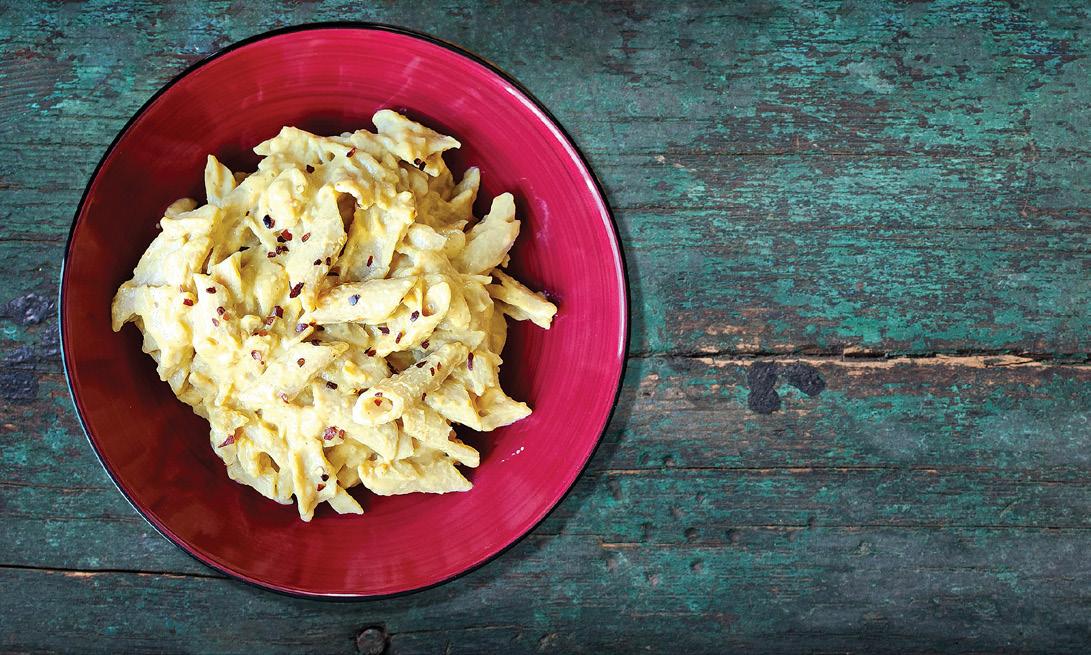
6. Mix well and warm over low heat.
7. Add salt and pepper to taste, and serve hot. The sauce will thicken slightly as it cools.
"I survived a severe heart attack and quadruple bypass in 2001. Following that first heart attack I struggled with the disease until November 1st, 2018 - the first day of excluding all animal, processed and oil-based foods."

Any shift in your choices towards whole plant foods will provide health benefits in chronic disease improvements. The dramatic changes in disease halting, reversing or disowning we have demonstrated, is the result of two commitments. One, eliminate all animalbased, processed and fast foods and two, consume only whole plant foods.
The savings you will achieve from the health burdens, stresses, anxieties, consultations, investigations, medications, procedures, loss of quality of life, time and money is considerable.
It’s clear, that I had inherited a bad selection of genes. Add to that, seventy years of a diet that included daily cod liver oil as a child, growing through adolescence with eggs, clarified butter known as ghee in food preparations, cow’s milk, curried chicken, ice creams, coupled with inherited genes, produced a disease environment which began in my childhood and emerged after my 53rd birthday.
Prior to changing my food lifestyle, meals largely consisted of meats, poultry, eggs, dairy, white rice and vegetables.
(Dated, 1st November 2018, with no expiry date.)
We consume only whole-plant foods consisting of vegetables, whole grains, beans, lentils, peas, dark leafy greens, cruciferous vegetables, mushrooms, onions, nuts and seeds and a whole selection of fresh or dry spices, condiments, fresh fruits and berries occupies our plates. We use minimally processed plant foods such as whole meal breads, pasters and rolled oats.
These foods have no cholesterol, and abundant fiber and healthy fats, healthy proteins, healthy carbohydrates and phytonutrients, anti-oxidants, vitamins and minerals. We aim for 30 different varieties of whole plant per week to achieve the best of human nutrition in 2000 calories of energy per day. Our main beverages are water and green or black teas. We add Vitamin B12 and D as the only supplements.
We avoid all meats, processed meats, fish, poultry, eggs, dairy, oils in food preparation and as dressings, processed and fast foods including sugar, energy and alcohol beverages.
These are loaded with cholesterol, disease promoting proteins, saturated fat, trans fats, refined carbohydrates including toxic chemicals, pesticides, herbicides, viruses, bacteria, industrial
In the second of a two part series, retired Melbourne GP, Dr Ralph Koelmeyer, covers the medical conditions that benefit from WFPB treatment. If you are interested in changing your diet he recommends the resources available at the following link.
www.doctorsfornutrition.org/general-public/getting-started/
supplied antibiotics, growth hormones, preservatives, food colouring and emulsifiers.
In contrast to plant food, animal foods have no phytonutrients and no fiber or little or no anti-oxidants.
The most disturbing is, red and processed meats have been classified as carcinogenic for bowel cancer, by the WHO since 2014, but carries no government warnings, (like tobacco and asbestos), benefitting the meat industry, to our risk.
The magic is how a simple dietary change has overcome a strong genetic tedendency and 70 years of chronic food toxicity. We were astonished when our chronic diseases began to regress and how that occurred within days and weeks!
Despite making significant advances, I still suffer health issues. Over 17 years of chronic diseases and medications has left me with a number of chronic disease burdens I experience every day. Damage from two heart attacks, has left me with a weakened heart, limiting my exertion, risking heart failure, arrythmias and possible strokes.
Long term medication side effects have affected my balance, impaired my memory and gait from muscle weakness. My quality of life is reduced, physical options are limited and my longevity may well be reduced.
The connection with your doctors is essential for your health and at time can be lifesaving. Being proactive by improving and maintaining your health with whole plant nutrition will reduce your dependence on the healthcare system, like we have experienced over the last four years.
All doctors now have the opportunity to instruct you and prescribe nutrition for your chronic disease. You can consult your doctor to guide you to achieve results as we have demonstrated.
At your next doctors visit, ask for a nutrition prescription, and they will be able to access the resource for you. Being informed yourself, will make your visit more productive. Having your doctor guide you with your medication reduction is an important part of your healing process.
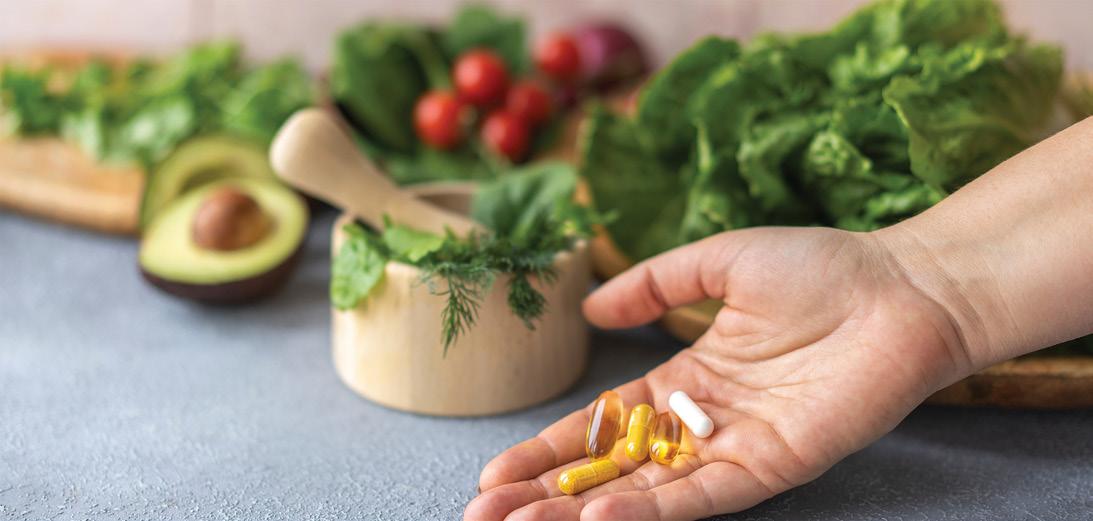
Currently we have numerous medications for each and every chronic disease. For example, type 2 diabetes has over forty different medications for the doctor to prescribe. Asthma, heart disease, arthritis and other common diseases will need two or more prescriptions each.
Coronary artery disease*
Angina
Claudication*
High blood pressure
Elevated cholesterol
Increased weight
Obesity
Type 2 diabetes
Erectile dysfunction*
Early kidney failure*
Early osteoporosis*
Early glaucoma*
Rheumatoid arthritis
Asthma
Sleep apnoea
Acne
Rosacea*
Psoriasis
Lupus, Multiple sclerosis
Gut related conditions:
Indigestion
Reflux disease
Gall bladder disease*
Inflammatory bowel disease
Irritable bowel disease
Diverticulitis
Constipation*
Suseptibility to dental caries*
Less severe respiratory infections*and less susceptible to covid infections*
Gynaecological conditions:
• Premenstrual syndromes
• Dysmenorrhea
• Polycystic ovarian syndrome
• Infertility (male and female)
• Sexual health dysfunction
• Menopausal symptoms can be more tolerable.
Others that can be improved:
• Type 1 diabetes
• Some back pain
• Tinnitus*
• Hand tremor*
• Stroke
• Depression,
• Osteoarthritis
• Easier to conceive
• Less nausea
• Less pre-eclampsia
• Healthier, happier children and grandchildren
Certain cancers can be prevented or survival can be improved including: bowel, breast, ovarian, uterine, endometrial, prostate.
*NB: Some of our aliments
As 50 per cent of Australian adults suffer from two or more chronic medical conditions, the medication purchases at the pharmacy becomes expensive. The side effects these multiple drugs can generate is an added burden to bear.
Whole food plant-based no oil dietary therapy is effective for most chronic diseases. As a guide, 80 per cent of aliments can improve 80 per cent of the time.
Effectiveness of this one therapy will depend on how strictly you comply, which disease and how far it has progressed. Some conditions are more or less responsive, depending on how strong your genetic predisposition is. The following are lists of common chronic diseases that can be halted, improved or even cured.
Safeguard your future, with healthy food choices at every meal, every day. Choosing to ignore a healthy lifestyle change, as I did in 1996, is the most significant health risk I took.
Once you receive that bad diagnosis, there may be no turning back. Reminds me of the line from Star Wars, “You are taking an awful risk Vader”, says Grand Moff Tarkin as Luke and Princess Lia are allowed to escape the Death Star.
I survived two heart attacks, but the Death Star with all its inhabitants, didn’t. Their “star attack” was fatal. In our population, 20 to 30 per cent of heart attacks are fatal.
I can hear myself saying, “use the plant-base lifestyle Luke”. If he had ignored the advice from Obi-Wan Kenobi, the Death Star would continue with devastating effect as heart and other chronic diseases do to our communities, every day. Disease prevention is a far better option than life-long symptom relief.
When I was made aware of plant-based nutrition, I was staring at a possibility of a leg amputation, heading for dialysis three times a week, possible hip fracture, and facing a third and possibly my last heart attack.
The decision to adopt a dietary change was a no brainer,
These conditions can respond well
change my food choices or be reckless and leave my family and friends to grieve at my disability or death.
You may not have that sentence hanging over you, but why take the risk of that next bad diagnosis. Especially if you have a family history or overweight or obese, which will increase your disease risk.
We have demonstrated how genetic family history burdens can be overcome. Similarly, lifestyle diseases like obesity and type 2 diabetes, which are associated with a long list of other chronic diseases, can also be overcome with effective and permanent whole plant food dietary change.
Changing one's lifestyle so dramatically comes with a price, given one's own personal situation. Once you have decided on a health journey, there are hurdles to overcome.
Many aspects of ourselves and of our society around us, will tempt us to unhealthy and toxic food choices. For example:

• Personal desire, conforming with family and friends, food cravings, gluttony and even animal and processed food addiction.
• Temptations and pressures from family and friends.
• Limited healthy choices at cafés, restaurants and food retail outlets.
• Compelling advertising from retail and the media to attract you to unhealthy choices.
• Convenience of fast (junk) food delivered any time, right to your door.
• Scarcity of healthy nutrition advice and direction from governments and authorities.
• Pharmaceutical and medical guidelines focused to maintaining chronic diseases for life.
• The lack of effective nutrition information, from your doctor for prevention and or disease reversal.

While there is community support for alcohol, tobacco, drugs and gambling addiction, there is little recognition of the widespread animal and process food addiction. Dietary addiction is far more common than all other addictions combined.
The prevalence of weight excess, now reaching 66 per cent in western societies, is a risk for numerous chronic diseases. Consider yourself very fortunate, as information about healthy nutrition and how to avoid the pitfalls, are readily available.
Unfortunately, the market place will try to profit from the plant-based food trend. Their primary interest is for profit and no intension to help your chronic disease.
You will be tempted and seduced, by the excess of these four ingredients: salt, sugar, saturated and trans-fats, included in foods, designed to increase their market share and to encourage your lifelong purchase and consumption.
The only food choice that has proven evidence, is whole-foods plant-based no oil nutrition, at every meal.
That choice we made in November 2018, achieved a life with a very different future from what we were heading for. Make that happen for yourself today, for a better outcome with your health.
WORDS BY SILVA A Boutique Content &You have the opportunity to change your future. Make it a permanent commitment for yourself and your family’s lifestyle, before you get diagnosed with that next chronic disease.
From that day on, you would be advised, encouraged and feel compelled to accept permanent treatment guidelines for symptom relief, while the best prevention therapy or possible cure, healthy whole-food plant-based no oil nutrition, takes no part.
Try these incredibly morish mozzarella sticks, they're amazing! Check out Stephanie's instagram @that.veganbabe for other amazing recipe videos.
 by Stephanie Manzinali
by Stephanie Manzinali
INGREDIENTS - cashew cheese
1/2 cup
1 cup
1/2 cup juice of 1/2
1 Tbsp
3/4 tsp
6 Tbsp
raw cashews ( soaked if you don't have a high speed blender)
plant milk
nutritional yeast
lemon
apple cider vinegar
salt (optional)
tapioca starch
INGREDIENTS - crumb
1/2 cup
1 tsp
1/2 tsp
1/2 cup
2 Tbsp
1 cup
whole wheat flour
Italian seasoning
garlic powder
pinch of salt (optional)
plant milk whisked with tapioca starch
breadcrumbs
1. First, make your cashew cheese by blending together all the cheese ingredients. Stir over medium heat stirring continuously until it becomes super thick and stringy!
2. Let that cool for 5 minutes then flour your hands and roll your cheese into sticks! Place onto a plate and freeze for at least 2 hours! This will ensure the cheese does not melt out when it is baking!
3. Prepare your flour bowl, plant milk bowl and breadcrumb bowl. Dunk your cheese sticks into the flour mix, into the plant milk, back into the flour, back into the milk and finally into the breadcrumbs to coat completely.
4. Air fry on 200°C (400°F) for 12-14 minutes or bake at 220°C (425°F) for 2025 minutes flipping halfway through!
Dunk in marinara sauce and enjoooy!
In the last edition we discussed the significant benefits of a plant-based diet in preventing dementia. People living with cardiovascular disease, obesity and diabetes are at a much higher risk of developing Alzheimer’s disease than those without these chronic health conditions.
Science acknowledges that a whole-food plant-based way of eating can help you manage and overcome these chronic conditions, and therefore plays a large role in preventing or slowing the development of dementia.
Another tool at your disposal in the fight against dementia is exercise. Quite simply, exercise and a plant-based diet are perfect combinations for optimal cognitive health.
Several studies clearly demonstrate that regular exercise improves memory, thought processes and cognitive function. Therefore, exercise plays a vital role in your dementia prevention strategy.
The National Ageing Research Institute Ltd (NARI) state that fewer than a quarter of older adults are getting enough physical exercise to achieve improved health outcomes. This means that less than 25 per cent of older adults are participating in adequate amounts of exercise.
Now that’s shocking!
Most people are not clear on where to start, and are left wondering “What’s the best exercise to do to keep Alzheimer’s disease at bay and improve my health?”

Alzheimer’s Society UK discuss a study of 716 participants with an average age of 82. The study found that those who were in the bottom 10%, based on the amount of daily physical activity, were more than twice as likely to develop Alzheimer’s disease when compared to the top 10% who were physically active every day.
The Finnish Twin Cohort study tracked 3000 twins at midlife from 1975 and 1981 and then followed up with the twins again between 1999 and 2015 to investigate cognition levels as they became older adults. The results showed that participating in moderate intensity physical activity (meaning more than a strolling walk) during midlife and beyond yielded a lower risk of cognitive impairment than in those who were sedentary.
The World Health Organization (WHO) states that moderateintensity physical activity “requires a moderate amount of effort and noticeably accelerates the heart rate.”
The WHO adds that this type of activity includes dancing, gardening, brisk walks, housework, being active with children and domestic animals, general home handyperson tasks like painting, and moving or carrying loads of less than 20kg.
Moderate-intensity physical activity is also known as a “cardio workout” or “aerobic exercise.” This means you are increasing your oxygen intake as your heart rate and breathing patterns increase.
Running, team sports, fast swimming and fast cycling are known as “vigorous-intensity physical activity” and are also beneficial for maintaining great physical and cognitive health as you age. However, studies have not differentiated between moderate and vigorous intensity exercise, nor whether one is better at minimising your risk of developing dementia than the other.
The University of Pittsburgh in North America published its findings from an ongoing 20-year study of the effects of walking and cognitive health. Dr Raji and his team observed 426 participants over 20 years. They analysed the relationship between walking and changes in brain structure.
After ten years the participants underwent an MRI to check for changes in the brain’s volume. A shrinking brain volume is indicative of brain cells dying. The findings of the study showed that those with greater brain volume were also the ones who were the most physically active.
Silva Mirovics is a Melbourne-based writer, yoga teacher, vegan and owner of Words by Silva. She has a degree in health science and a research Masters in Gerontology.
"Alzheimer’s is a devastating illness, and unfortunately, walking is not a cure. But walking can improve your brain’s resistance to the disease."
Well, they walked just shy of 10km per week for the duration of the study. Simply by walking at a moderate pace they maintained their brain volume and greatly reduced their risk of cognitive decline. Currently, there is no cure for Alzheimer’s disease, and expensive trials and treatments are providing inconsistent results. Dr Raji states “Alzheimer’s is a devastating illness, and unfortunately, walking is not a cure. But walking can improve your brain’s resistance to the disease and reduce memory loss over time”.
Now that is great news.
Your brain controls everything that happens within you. Internal and external, physical, emotional – nothing happens
without your brain. Imagine if you could keep your brain firing on all cylinders with a simple, and cost-effective strategy: Good old-fashioned exercise.
To give your brain the best chance to age well, you must nourish it with whole plant foods, and move your body to get the heart pumping, every single day. Your brain will love you for it.
If you are not able to walk it could be very useful to contact a physiotherapist or personal trainer who can advise you on the best type of aerobic activity to suit you. That way you can experience all the benefits of exercise, raise your heart rate and boost your cognitive function.
Next time you read a headline that fast-paced walkers are less likely to develop Alzheimer’s disease, you know there is definitely truth to that statement. So, what are you waiting for? Get those walking shoes on and get moving.

This exquisite dsih contains healthy fats, and is a wholesome meal or side that can be added to any part of your whole food plant based menu. by Polly Baptist | Instagram @pollybaptist | serves 4
1 cauliflower - broken into small florets
1 jalapeño sliced
8 cloves of garlic skins on
1 tin organic chickpeas drained -keep aqua faba in a glass jar for future use ( mousse / cookies / cake )
2 tbsp dried organic turmeric
2 tsp chipotle powder
1 tbsp Spanish smoked paprika
1 tsp salt
2 tbsp olive oil (optional)
1/2 lemon squeezed
Cracked black pepper
Tahini sauce
2 tbsp tahini - hulled
1 scant tbsp maple syrup
2 tbsp lemon juice
enough cold water to loosen the mixture salt
Pickled shallot
1/2 finely sliced banana shallot
2 tbsp Apple cider vinegar
2 tsp maple syrup
pinch of salt
Crunchy puffed quinoa
1/2 cup puffed quinoa
1/2 tsp dried organic turmeric
pinch cracked pepper
pinch of salt
1 tbsp coconut oil (optional)
2 tsp maple syrup
To serve
1 cup of coriander leaves
1 avocado sliced
1 spring onion sliced finely
1. Turn the oven on to Gas mark 6 / 200°C / 400°F
2. Prepare a baking tray with baking paper - large enough to hold the cauliflower florets.
3. Prepare a small baking tray with baking paper - for the quinoa puffs.
4. Pickled banana shallot - Mix the apple cider vinegar and maple syrup together, in a non reactive bowl. Add the finely sliced banana shallot to the bowl and toss well with a small pinch of salt and set aside.
5. Cauliflower - Break the cauliflower into small florets taking them off the main core and place them in a large bowl and drizzle over the olive oil or water
and toss well. Sprinkle on the spices, salt and pepper and toss well, before tossing in the garlic cloves and lemon juice.
6. Spread over the prepared baking tray and place in the middle of the oven, and roast for 20 mins.
7. Whilst the cauliflower is in the oven put the sliced jalapeño and chickpeas into the bowl that the cauliflower had been tossed in and toss again with the oil and spices left in the bowl. If you want to add more feel free to add some more spices. It is all dependent on the site of your cauliflower as to how much of the spice mix is used !
8. After 20mins take the cauliflower out of the oven and add the chickpeas and jalapeños and toss everything on the baking tray.
9. Place back in the oven for another 20 mins, before tossing and allowing to cook for another 10mins, before removing and resting on the bench.
10. Quinoa - Prepare the puffed quinoa by tossing it in a bowl with the turmeric, pepper, salt, coconut oil and maple syrup and place on the prepared baking tray and place in the oven when you place the cauliflower back in the oven with the chickpeas and jalapeño.
11. Check the quinoa puffs after 20 mins and toss and then place back in the oven for another 20 before taking out to cool and crisp up - do not let them burn, so keep checking on them, every 10 mins.
12. Tahini sauce - Whilst the cauliflower was cooking prepare the tahini sauce. Place the tahini, lemon juice, maple syrup and salt in a bowl and mix well. Add water slowly to loosen the mixture. Taste and season with some more salt or lemon juice.
13. Lay some of the sauce on a platter and place the cauliflower, chickpeas and jalapeño top with sliced avocado, sliced spring onions, and coriander leaves, sprinkling on some of the crispy quinoa, Serve the roasted cauliflower with extra sauce on the side and some baby spinach.
Some of the health benefits of this meal consist of being high in fibre, having over 14 different plants in it, full of antioxidants, sulforaphane an antioxidant that is good in helping suppress cancer, reducing high blood pressure and helps in keeping the arteries clean. It is low in carbohydrates, and high in whole foods, the quinoa is a pyseudograin and is packed full of flavonoids which are anti inflammatory, it is gluten free and is a great source of protein. Using the leaves of the cauliflower helps in less wastage and also adds a different element to the dish.

Political and collective action is key. If we, as individuals, shoulder the blame, judging each other and bearing the burden of every solution, it lets corporates and rampant profiteers off the hook..
The kitchen: heart of the home, where lowering our carbon footprint can happen in leaps and bounds while we enjoy the whole process! Well, that’s what I was enthusing about with a chap I met recently. We were discussing how the world could be a better place, and the conversation was going well - until.
“Climate change,” he scowled. “They’re calling it the climate crisis now. We have a housing crisis, a cost-of-living crisis. Climate change, yes, but not a crisis. They want to blame us. We can’t fix the problem, but they want us to think we can, get us buying green this and that. More stuff. Bad for the environment. Good for business. Eating plants and alternative transport isn’t going to save the world. Being all caught up in little feel-good steps like that distracts us from pressuring the government. They’re the ones who have to step up. Corporates and governments around the world. The big players. The system has to change.”
I was about to agree about stepping up, but he kept talking.
“They want us to drink oat milk, stop cooking with gas, give up meat and cheese, buy an electric car. All that lithium, plastic, and metal ... bad for the environment. As for those plant milk tetra paks. It’s pollution. I’m passionate about the environment ... That’s where we can really make a difference.”
I didn’t mention the obvious; that climate change is devastating the environment. But I was interested to hear what he’s doing. Ditching plastic, composting, tree planting, beach clean-ups, op-shopping. Reducing, reusing, repurposing, recycling. On an individual level, the same little feel-good steps I’m taking. Except. He is avoiding alternative transport, regenerative energy and plant-based eating, the very areas Big Oil and Big Ag want us to avoid. Where individuals can make a noticeable difference. Interesting.
We parted agreeing, though, that political and collective action is key. If we, as individuals, shoulder the blame, judging each other and bearing the burden of every solution, it lets corporates and rampant profiteers off the hook. This intensifies
the problem, and everyone suffers more. Especially the increasingly disenfranchised poor.
No single person or country can save the world. But as individuals supporting wider-good action campaigns, voting, living more in harmony with nature, and helping each other in the community, we’re part of the movement effecting change. Our little steps do add up. This gives me hope, and the strength to carry on.
If we ever meet again and he asks for ‘little step’ kitchen tips, I hope he’ll enjoy chatting over a delicious plant-based lunch…
• Using fewer luxury and imported ingredients and replacing them with locally grown and manufactured foods reduces food-mile emissions and strengthens food security. Walnuts, for example, instead of cashews. Australian sultanas and staples we can’t grow, instead of those from the other side of the planet.

• Keeping everything visible in the pantry and fridge helps reduce waste when ‘out of sight, out of mind’ ingredients pass their use-by date.
• Getting creative with left-overs and unused produce helps get us closer to zero waste. If you have a juicer, juice vege stalks, and other produce you might otherwise throw out. Great for stock.
• Walking, cycling, mobility-scooting and taking public transport to the shops reduces fossil fuel use. If you can’t, and you don’t have an electric or hybrid car, make fewer, more efficient trips. Maybe take turns with another household.
• Cooking without oil and fat radically reduces the need for dish detergent, helps prevent ‘fat-bergs’ forming in drains, and results in healthier grey-water and healthier air.
• Pressure cooking uses much less energy, saves a lot of time, and makes food more digestible. More nutrients
are made available too. Great for beans and beetroot!
• Being minimalistic with cleaning and personal care products, reduces our environmental footprint. Using fewer products from businesses that aren’t ‘greenwashing,’ helps up-the-ante in the marketplace.
• Choosing essential appliances with a good energy-star rating, and resisting the impulse to buy novel, singleapplication electrical gadgets that end up not being used, reduces the plundering of the world’s natural resources, and junk in landfills.
• Choosing an electric stove rather than gas reduces fossil fuel use. New research also reveals that regular fumes from cooking with gas indoors is damaging to our health.
• Filling the dishwasher before using it, turning taps and lights off when not in use, covering the pot when steaming or boiling – we do that already, surely?
• Reusing glass jars adds value to homemade pickles and jams.
• Using reusable ‘unpaper’ towels, cloth serviettes, tablemats in natural materials, and waxed-cloth food wraps and bowl covers, is better for the environment.
• Motel shower caps make great bowl covers! Or reuse Gran's food covers or make some from old net curtains.
• Using mum’s old hand utensils saves electricity, strengthens the arm muscles, and enhances your retro kitchen look. Great to have in a power cut.
Innes Hope
He’s leaning back in a café chair, Staring at the atmosphere. How much C02’s up there?
Evidence shows more than enough. Thousands of scientists measure the stuff, (In ‘parts per million’ they report, Writing ‘ppm’ for short).
He searches the web - danger, danger!
Four-Seventeen? That is major!
Three Fifty should be the max. His stomach churns, he can’t relax.
Cries ‘Waiter! Can I change my order?
Can I have the plant-based burger?’
He sits on the edge of that plastic chair, Staring at the atmosphere
• If you’ve no room to grow food, or the landlord won’t even allow pot plants, guerrilla gardening or a community garden might be for you. Guerrilla gardening is growing food on neglected public land.
• It is better to avoid buying products that need to be recycled. A worrying amount of stuff we put out for recycling is not recycled, despite it being clean and in the right categories. Recycling as the final straw helps us prevent, reduce, reuse, and repurpose, avoiding waste in the first place.
• Tetra Pak/aseptic cartons can now be recycled. They’re made into building board by saveboard.nz. Pressure your local council to provide this service.
• Soft plastics can also now be recycled. They’re made into planter boxes and fence posts. Find your nearest depot via recycling.kiwi.nz/store-locator
• Eating plant-based creates more food scraps for composting and worm-farms than traditional diets. Healthier soil, healthier plants.
• Using genuinely compostable products, e.g. sponges, wooden brushes, etc, causes less pollution.
• Packaging made of natural materials can be composted, reused, and more effectively recycled, e.g. oatmeal in paper bags, peanut butter in glass jars. Don’t be fooled by brown-paper-looking plastic. Check the compostability of plastic-lined paper and card.
• When the plastic lining in your jute shopping bag is disintegrating, (see image) peel it off and put it in the soft plastic recycling. The bag looks as good as new. Happy, sustainable, eco-shopping!
Innes Hope works in the arts, crafting thoughts into words, verses and recipes for a better world.
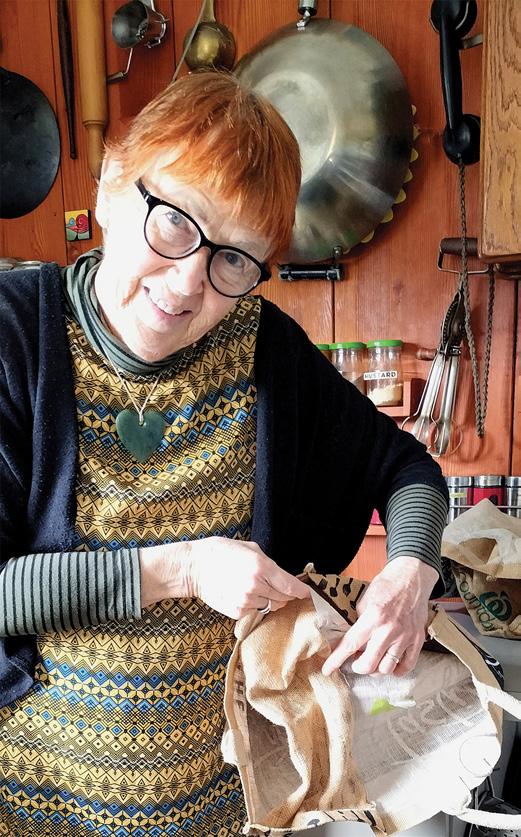

Potage, the traditional staple food across Europe for centuries, often included foraged roots and greens. Everyone ate it in one form or another. The wealthy enjoyed various exotic varieties based on meat, fish, or game, while the average worker made do with vegetables, herbs, and grain. Potage kept thousands of people alive during times of famine. When affluent families started planting cottage vegetable and herb gardens, sometimes with a fruit tree or two on the perimeter, these became known, and still are in some places, as ‘potagers.’
Pease Porridge, valued by common folk in Old Britain is a potage made of dried yellow peas, boiled until they’re as thick as hummus. Today’s version is Pea & Ham Soup. Minus the ham, it’s a delicious way to enjoy natural, un-processed pea protein. Dhal, the Indian version, is spiced with cumin, coriander, turmeric, chilli, and so on. Yum! Minestrone is a popular Italian version. For Native Americans, corn and beans were used, and sometimes acorns, chestnuts, or walnuts were added. Yes, under many different traditional names, and in many forms, potage is eaten around the world, with vegetables included or served alongside the thick grain or legume mush. Sweet forms of English and French potage, made with grains, dairy milk, or almond milk, became known as porridge.
• Water, or saved vegetable-cooking water.
• Either soup mix, or a small amount of whole grain of your choice, e.g. buckwheat, corn, kibbled wheat, barley, steel-cut oats, and nowadays, quinoa, amaranth, etc.
• Legumes, e.g. fresh, canned, or dried, e.g. peas, beans, mung beans, lentils, etc.
• Fresh or frozen vegetables, root veges and greens.
• Optional extras; edible flowerheads of cabbage, herbs, spices, etc.
If you fancy venturing into the romantic realm of savoury medieval English potage recipes, gather some oatmeal, violet & strawberry leaves, endive & chicory, marigold flowers, scallions, spinach, parsley, wild prickly-oxtongue herbs, and mutton offcuts. Hmm … prickly herbs and mutton? Maybe not so romantic after all!
Food is a symbol of social status, with meat at the top of the ladder, and weeds at the bottom. Ironically, peasants working outdoors anywhere in the world who could eat sufficient amounts of good potage, and very small amounts of animal food, may well have been healthier than the privileged ruling class. Now we know why; the rich grabbed most of the animal food, and the poor only got enough to supply essential Vit B12. The bulk of their diet was plant-based whole foods.
Meanwhile, here we are in 2023, shopping bag in hand, musing on what’s on the shop shelves. I’ve a surprise for you. Take a close look at a packet of ordinary soup mix. Yes! - it is potage mix! The basic ingredients, cereal and legumes! Cook as is or add veges of your choice.
Still nourishing us to this day, potage has got what it takes to see us through hard times. Make it your own way, as thick or thin as you like, and you’re keeping ancient cultural traditions alive, and yourself well.
1. Soak any large dried grains and beans, chickpeas, etc, overnight.
2. Boil these in the water or vege water until everything is soft. If you’ve a pressure cooker, this won’t take long at all. If top-cooking, stir occasionally to prevent the ingredients sticking to the bottom of the pot. Add more water if necessary.
3. Add any quick-cooking grains, e.g. quinoa, (strictly speaking, quinoa isn’t a grain, but that is irrelevant). Keep the pot gently simmering and keep stirring if necessary.
4. While the brew is stewing, chop or grate the root veges and toss them in, then the greens, herbs and spices of your choice. Cook everything a little longer until the flavours merge. Taste and tweak by adding the likes of a little lemon juice, salt, or extra seasonings, then you’re done! Serve with bread to dip into the potage. Either serve it sliced in thick ‘sops’ (strips) or break the bread as you eat.
The first randomized prospective clinical evaluation of the effects of fasting on chemotherapy (the “incidence of chemotherapy-induced nausea and vomiting in cancer patients”) was published in 2014, but the patients were dogs. Cancer-bearing dogs presenting at a veterinary hospital were randomized to be fasted for 24 hours before chemotherapy, and those that were were significantly less likely to suffer from vomiting—only 1 in 10 compared to 2 out of 3 in the nonfasted group, which is great.
But what can that tell us about human medicine? Evidently, not much. It is nearly impossible to rely on most animal data to predict whether or not an intervention will have a favorable clinical benefit–risk ratio in human subjects.
For example, mice have a metabolic rate approximately seven times higher than humans, so a single day of fasting can cut lean body mass by about 15 per cent. That would take over a month of fasting in people. So that dramatic study on mice showing 100 per cent alive versus 100 per cent dead on high-dose chemo depending on whether they fasted for 60 hours? What can that really tell us?
And when it comes to cancer, rodents can bear massive tumour loads, whereas people generally waste away and die when tumour masses have reached just a thousandth of our body weight. You can’t even necessarily extrapolate from one rat to another, even within the same strain bought from different dealers.
The only way to see what happens in humans, the only way to guarantee findings are relevant, is to study people. The theory is that combining fasting cycles with chemotherapy could extend the survival of advanced-stage cancer patients by both retarding tumour progression and reducing side effects––or even providing an alternative to chemotherapy altogether for early-stage cancer patients. But that’s all contingent on being confirmed in human clinical trials.
First, there was a case series. Several patients diagnosed with a wide variety of cancers elected to undertake fasting prior to chemotherapy and share their experiences. Those who underwent chemo both with or without fasting reported a reduction in fatigue, weakness, and gastrointestinal side effects while fasting; in fact, felt better across the board, with zero
Dr Michael Greger is highly respected for his insightful reviews on the science of plant-based eating. In this piece (republished under Creative Commons license) he examines the impact that fasting and food can have on patients undergoing chemotherapy. For more, check out his very informative website.

www.nutritionfacts.org
vomiting in the fasting group. The weight lost during the few days of fasting was rapidly recovered in most of the patients and did not lead to any detectable harm, so overall was looking feasible, and safe, with the potential to ameliorate side effects.
But only randomized clinical studies could tell for sure, and so here we go. Breast and ovarian cancer patients fasting starting 36 hours before and ending 24 hours after chemotherapy, did appear to improve quality of life and fatigue, but another study found no such beneficial effects. There did appear to perhaps be less bone marrow toxicity, given the higher counts of red blood cells and platelet-making cells. But no benefit when it came to killing off white blood cells—the immune system cells—so that was a disappointment. Perhaps they didn’t last long enough? They only fasted 24 hours before and after.
To find out the optimal duration, 20 cancer patients were split up into three groups, fasting for 24, 48, or a total of 72 hours. All those in the 24-hour group suffered nausea after chemo, but less than half in the 72-hour group, and most were vomiting in the 24-hour group, but none in the longest fasting group. Longer fasting groups also tended to suffer less nerve damage and less serious bone marrow suppression. Even after 24 hours of fasting, two cycles of chemo can knock people’s white blood cells down to suboptimal levels. But with 72 hours, chemo knocked their immune system down but not out.
Okay, so short-term fasting may reduce chemotherapyinduced toxicity. But what I want to know is if it makes it work better. A systematic review of 22 studies found that overall, fasting was found to not only reduce chemotherapy side effects (like organ damage, immune suppression, and chemotherapyinduced death) but also to suppress tumour progression,
"The bottom line in terms of fasting is that, at present, long-term fasting in cancer treatment is supported only by some case reports; so, more research is desperately needed."
including tumour growth and metastasis, resulting in improved survival. But… nearly all of the studies were on lab animals.
The studies on humans are limited to evaluating safety and side effects. The tumour-suppression effects of fasting, for example, its influence on tumor growth, metastasis and prognosis, have not been evaluated - until now
In 2015, a remarkable case report was published in which a woman with stage three follicular lymphoma underwent a medically supervised, 21-day water-only fast, after which her enlarged lymph nodes were substantially reduced in size. The patient then remained on a whole food, plant-based diet, and at six and nine-month follow-up visits she remained asymptomatic.

In 2018, her three-year follow-up was published. Remarkably, she appeared to remain cancer-free, confirmed by CT and PET scans. Her cancer appeared to have been knocked down and out. The initial regression persisted for three years with no additional intervention other than the dietary change.
Could it have just been a coincidence? Sure, but the initial regression directly coincided with the timing of her water-only fast, suggesting a causal relationship, and there are biological mechanisms by which fasting may potentiate tumour regression, such as decreasing levels of insulin-like growth factor 1 (IGF-1).
regression. So, 1 in 25 cases just go away on their own. But, when you have follicular lymphoma cases in which tumours shrink after any kind of treatment—in this case after some herbal supplement—you always have to ask: is this cause-and-effect or just coincidence?
Elevated natural killing activity may be one of the possible mechanisms responsible for spontaneous regression of malignant lymphoma. Natural killer cells may be part of our first line of defence against cancer by destroying tumour cells. And if you compare the natural killer cell activity of those with malignant lymphoma that spontaneously regressed, versus those whose cancer didn’t, or a control group, the spontaneous regression group does seem to be on the high end.
How can we increase natural killer cell activity naturally? Exercise can do it, unless, apparently, you’re eating a high-fat diet. Those randomized to undergo an exercise training program on a high-fat diet actually suffered a decline in natural killer cell activity, suggesting training on a high-fat diet is detrimental to the immune system.
Eating lots of contaminated fatty fish may also adversely affect natural killer cell levels. But put people on a low-fat diet, and you can dramatically increase natural killer cell activity within a matter of months by about 50 per cent, suggesting that dietary fat might increase the formation of cancer by depressing the
The term “spontaneous regression” of cancer is a misnomer. Obviously, there was something that caused the regression, whether or not we know what it is. Presumably, the immune system plays a role. The fact that you can get a marked increase in cancer rates when you are immunosuppressed suggests that cancers are popping up all the time, but your immune system is normally able to keep them at bay.
There was an example, for instance, of a regression after a transfusion of blood from a patient who had previously sustained a spontaneous regression; or cases of patients who had been free of metastases for 15 or 20 years, only to develop rapidly fatal metastases after some type of stress or shock that apparently sharply reduced their resistance.
For most cancers, spontaneous regression is exceedingly rare, but lymphoma is an exception. Of 140 cases of nodular lymphoma (which is what they used to call follicular lymphoma), there were 18 cases of at least partial and 6 cases of complete
tumour surveillance capacity of the immune system.
The bottom line in terms of fasting is that, at present, longterm fasting in cancer treatment is supported only by some case reports; so, more research is desperately needed. Sadly, there is currently no clinical research evaluating the effects of water-only fasting and a whole food, plant-based diet on follicular lymphoma in humans.
Long-term fasting is certainly not without risk. In one case, a guy opted to try a 60-day fast instead of chemotherapy for non-Hodgkin lymphoma. He ended up hospitalized in a coma and respiratory failure because of Wernicke encephalopathy, a life-threatening neurological emergency caused by thiamine deficiency. But starting on a healthier diet seems like a win-win no-brainer. Just putting people on a plant-based, whole foods, sugar-oil-salt-free diet, with or without fasting, is sometimes sufficient to induce an intense healing response.
Low fat! Hot, squelchy, cheesy-ish filling. Yeast, nut & soy free.
by Innes HopeA‘Cheese’ sandwich made from hummus - really?
Well … no plant-based cheese is the same as dairy cheese. But hummus with cumin instead of garlic, has a lovely, subtle cheesy flavour when cooked between wholegrain bread.
It’s a staple at our house and is a much healthier food than highly processed vegan cheese. If you need to make a batch first, the recipe is below. It won’t take long if you use canned chickpeas.

1 can 1/4 cup
1 Tbsp
soft-cooked chickpeas (approx 11/2 cups)
lemon juice
salt to taste (optional)
ground cumin to taste (approx. 1/2 - 3/4 tsp)
tahini (unhulled has the best flavour)
1. Drain & rinse the chickpeas. Juice some lemon to make a ¼ cup.
2. Whizz chickpeas, lemon juice, salt and cumin in a food processor until the mixture is smooth and thick.
3. Add the tahini and blend again.
Spread x2 slices of wholegrain bread with cumin hummus. Add sliced fresh tomato if you fancy. Sandwich together and toast both sides in a nonstick pan or sandwich maker. No need to use oil or margarine; you’ll have a trimmer waist, a better taste, better health, and your pan or sandwich maker will be easier to clean. Ta da!
Spicy Thai larb salad as you have never had it before, as spicy as you wish by Nicole Morgan | Instagram @plantstrongliving | Serves 4-5

4
2 Tbsp
6 Tbsp
1/4 to 1/2
2 Tbsp
dates, pitted
peanut butter
white vinegar
chilli, seeds discarded (we recommend using the ½ chilli but for a lighter kick go for the ¼ of the chilli)
coconut aminos seasoning
2 cups
1 cup
1 lrg
4 Tbsp
2 Tbsp 6 1 1 1
cashew pieces
tofu crumbled to resemble mince (or grated)
knob of ginger, peeled & grated
coconut aminos seasoning or Matakana
sticky coconut amino sauce
lime juice
garlic cloves, minced
red onion, halved & finely sliced
iceberg lettuce, whole leaves separated cucumber ends cut off, halved and sliced lengthways
Bunch of basil chopped
1. In a medium pot bring the rice and 4 cups of water to the boil, reduce the heat. Cover and simmer for 25 mins, leave for 5 mins and fluff with a fork.
2. To make the chilli sauce, in a high-speed blender blend the dates, peanut butter, white vinegar, red chilli, and 2 tbsp coconut aminos seasoning. Blend until smooth. Set aside
3. Over low to medium heat in a large nonstick fry pan, toast the cashews until lightly browned, approx. 2-3 mins. Set aside in a bowl.
4. Using the same fry pan over medium to high heat. Start dry frying the tofu stirring often (this allows the tofu to dry up and lightly brown), approx. 5-7 mins.
5. Now add the ginger, combine well, dry fry for a couple of minutes. Add in 4 tbsp of coconut aminos seasoning, combine well, dry fry for a further few minutes. Now add 4 tbsp of the chilli sauce and the lime juice, mix well and dry fry for a couple more minutes. Finally add the minced garlic, incorporate all the ingredients and fry for a final minute or two until fragrant.
6. Take the lettuce leaves, fill them with the rice, red onions, cashews, tofu, cucumber, a sprinkling of basil leaves and drizzle over the rest of the chilli sauce.
You can see it in the eyes of a mother as she catches first sight of her newborn child, it happens when we gaze up into a star-spangled night or stare deep into a tropical ocean. But what actually is this ‘magical’ thing we call awe? What we certainly know is that we all sense it, and probably have done since the dawn of time, but for most of us, it’s just a feeling perhaps. Something that doesn’t need explanation, we just can’t put a finger on that’s all.
The problem with awe is that it not only applies to things we can see but also to things we don’t know much about or are told we should be concerned about.
Take, for instance, the picture above. Few of us would ever doubt the awesome power of a tornado as it trawls its way across the American mid-west, but what if we told you that the picture itself isn’t actually real? It was, in fact, created with artificial intelligence now available in the latest beta version of Photoshop.

Awe not only inspires aspirational thoughts; it can also induce fear.
Where artificial intelligence is concerned, Australian existential thinker Toby Ord sees ‘unaligned AI’ as a serious threat to humanity. Currently, he estimates a one in ten likelihood that unaligned AI will cause human extinction or permanent and drastic curtailment of humanity's potential unless significant steps are taken. The argument here is that, once an AI reaches a certain level (or quality) of intelligence, it will be better at designing AI itself, than humans. Ord sees five big risks: those around nuclear war, climate change, other environmental damage, engineered pandemics and what he
describes as unaligned artificial intelligence.
"While I see the final two as especially important, I think they all pose at least a one in 1,000 risk of destroying humanity’s potential this century, and so all warrant major global efforts on the grounds of their contribution to existential risk," he ominously warns in his book, The Precipice.
An existential risk is certainly something that can cause awe - of the fearsome kind that is.
For most of us though, this strange, if temporary phenomenon or emotion, is something that simply envelops us as we view the southern aurora or the northern lights or gaze at a great work of art, watch a ballet or marvel at an orchestra as its meticulously created sounds wash over us.
And where would human beings be without it? Somehow we all like to be inspired. Perhaps it drives our basic curiosity about what lies over the next hill. In the past it drove us to cross the oceans of the world and led us to create machines to explore the universe.
The question of what awe really is has fascinated Berkley’s Dr Dacher Keltner since he was a child.
Keltner has been studying human emotion for decades and is a co-founder and director of UC Berkeley’s Greater Good Science Center, a research institute that probes questions about our social and emotional wellbeing.
His latest book, “Awe: The New Science of Everyday Wonder and How It Can Transform Your Life,” explores the social, physical and mental benefits of this powerful emotion. He approaches the subject, in part, from an anthropological perspective, exploring how
this emotion shapes our social fabric.

“As a species, we are very interdependent,” he told CNN's Eva Rothenburg. “But the central challenge to healthy social networks, which is vital to our health, is unbridled self-interest.”
The power of awe, he argues, is that it motivates us to see beyond our own desires. It “quiets the voice of the self” and, consequently, “makes you share things and collaborate with other people.”
Central to our understanding of awe, Keltner holds, is its relevance to human health and the role it plays in healing. Close interpersonal connections and our overall happiness and health were the subjects of the Harvard longitudinal study on interpersonal relationships. The study was started back in 1938 and followed 268 participants.
Of the original cohort, only 19 were still alive in 2017, when further evaluations were released. Those remaining were all in their mid-90s. Among the original recruits were eventual President John F. Kennedy and longtime Washington Post editor Ben Bradlee. Women weren’t included because the College was still all male.
Six years ago, Keltner co-authored a study mapping the selfreported emotions of over 850 participants as they watched more than 2,000 short videos. The researchers catalogued 27 emotions, some of which were more likely to co-occur and so were considered related.
The study found that awe was experienced as a distinct emotion, different from beauty, although it was often reported alongside “admiration” and “aesthetic appreciation.” Keltner concludes,
therefore, that it’s important — albeit difficult — to differentiate stimuli that are simply beautiful from those that tend to evoke awe.
Much of Keltner's initial work was inspired by his efforts to make sense of life after his brother's death.
" I took a moment each day to be open to the awe-inspiring around me. I sought out places of importance in the history of awe. I engaged in open-ended conversations with people I consider awe pioneers. I immersed myself as a newcomer in various wonders of life. They brought me to the conviction that awe is almost always nearby, and is a pathway to healing and growing in the face of the losses and traumas that are part of life," he says in his book.
In association with other researchers, Keltner partnered with Google Arts and Culture in 2021 to map emotions users reported when looking at different artworks online. From 1500 works, participants reported 60 artworks made them feel some level of awe. Other words they chose to describe these works were “mysterious,” “striking,” “cosmic,” “spiritual,” and “intimate connectedness.”
To understand and appreciate your own sense of connectedness, Keltner says it's important to slow down and drink in your surroundings.
“Look for things that challenge your scale, both small and vast,” he said — anything from a pattern created by flowers near the sidewalk to the silhouette of your city’s skyline on your commute. He promises you’ll thank yourself later.
Why are we so moved?
A new type of thinking is essential if mankind is to survive and move toward higher levels. - Albert Einstein
Making your own granola bars at home is SO easy and best of all you know exactly what’s in them!

Check out Stephanie's instagram @that.veganbabe for other amazing recipe videos.
by Stephanie Manzinali2.5 cups
1 cup
3/4 cup
2 tsp
1/4 tsp
1.5 cups
1/2 cup
1/2 cup
1/4 cup
1/4 cup
oats
walnuts
cashews
cinnamon
salt
medjool dates (about 22 dates)
pumpkin seeds
dried cranberries
chia seeds
maple syrup (optional)
1. First pulse your dry ingredients (oats, walnuts, cashews, cinnamon, salt) until they turn into a fine powder then add them into a large bowl. You can use a mix of any nuts you’d like!
2. Next add in the dates and pulse to break them down into tiny pieces then add them into your bowl with the dry ingredients.
3. Add in the mix in’s - you can add in anything you’d like. Mix to combine and use your hands to make sure everything is well incorporated.
4. Press the mixture down into a lined baking dish then flip it out and slice the bars into your desired shape.
5. Spread onto a baking sheet and bake at 350f for 20 minutes.
6. Store in a sealed container and enjoy throughout the week
This super easy quiche is a crowd winner, very quick to put together and packed with flavour. by Catherine Barclay | serves 4
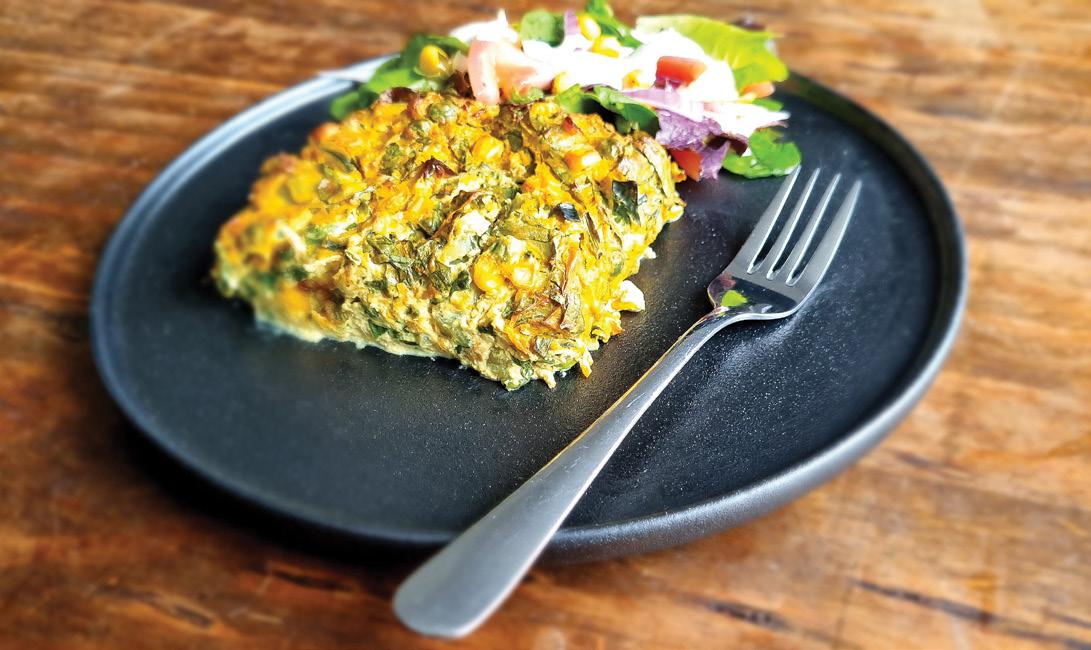
1 - 2 cups
baby spinach, stalks removed
1. Preheat oven to 200°C (410°F)
6
1/2 cup 1/2 cup 2 240 gms
1/3 cup
1/2 cup
2 1/3 cup
1 cup
1 1/2 tsp
2 tsp
1/4 tsp
1 tsp
1/4 tsp
garlic cloves, minced
carrots, grated
frozen peas and corn, cooked
sml courgette
silken tofu, drained, broken into pieces
plant milk
brown onion, diced
thyme sprigs
nutritional yeast
red capsicum, diced
smoked paprika
dijon mustard
ground turmeric
miso paste
black salt - kala namak
ground black pepper to release the turmeric benefits
2. Add a small amount of water or vegetable stock to a stock pot with garlic, onion, carrots, and dry fry until onions are transparent.
3. While cooking the veggies, place the tofu, plant milk, herbs and spices into a blender and blend until smooth.
4. Combine all ingredients into a large bowl and fold until combined.
5. Transfer mix into a square casserole dish around 25cm wide, then bake for 25 mins.
6. Once cooked, remove from oven and leave it to stand for 10 mins to set before serving.
For as long as humans have grown our own food, we have battled pest animals that destroy crops and take food for themselves. The traditional approach has been to try to kill the pests, typically with poisons. Too often, however, this fails to kill enough pests, harms native animals, and only minimally reduces damage.
We tackled this problem in a different way by asking: how do we stop hungry animals finding our crops in the first place?
In a research paper published last month, we show how “chemical camouflage” can prevent house mice from finding newly sown wheat seeds. The method reduced mouse damage to wheat crops by more than 60% even during plague conditions, without killing a single mouse.
Rodents are responsible for an estimated 70 million tonnes of grain lost worldwide each year. Even a 5% reduction in these losses could feed more than 280 million people.
In Australia, the 2021 mouse plague cost farmers in New South Wales alone upwards of $1 billion, according to an industry association estimate. A mouse plague occurs somewhere in Australia at least every four years.
Currently, the only management option to reduce mouse numbers is broad-scale baiting. However, baiting is often ineffective and has led to calls for more lethal poisons, which carry major risks for native wildlife.
The relationship between baiting effort and crop yield is not well understood, and mouse numbers typically crash in plague years even without intervention. A better approach is to focus on reducing mouse impacts, rather than mouse numbers.
Mouse damage to Australia’s most valuable crop, wheat, occurs mostly in the two weeks between sowing and germination. During this time, mice are attracted to the smell of the wheat germ – the nutritious and fatty part of the seed –beneath the ground, and they learn to dig up seeds with pinpoint accuracy, leading to significant crop losses.
This led to our question: can we hide the seeds so mice can’t find them?
Like many animals, mice primarily use their sense of smell to find food. The world is full of odours, and hungry foragers must prioritise important smells and disregard useless ones.
When a food is too difficult to find, or an odour is not a useful indicator of food, foragers must give up and search for something else to avoid wasting energy.
Because hungry animals can’t afford to waste effort on odours that don’t lead to food, they are vulnerable to olfactory misinformation and chemical camouflage. As with visual camouflage, if the background, in this case, smell, appears the same as the item we are trying to hide, the target item cannot be distinguished.
Animals can also learn about the usefulness of information,
For several years now, a group of conservation experts from the University of Sydney have been working on ways to outfox rodents that come to destroy almost every food crop we humans grow. In the following article, republished under Creative Commons license from The Conversation, Professor Peter Banks and his associates, Finn Cameron Gillies Parker, Catherine Price and Jenna Bytheway, explain how they made it happen.
making them vulnerable to another form of misinformation –odour pre-exposure. By deploying food odours before food is available, foragers initially attracted to the odour repeatedly receive no reward and learn to ignore it.
When the food does become available, foragers don’t follow the odours because they know they’re unrewarding. We recently used this technique to dramatically improve nest survival for threatened shorebirds at risk from by predation by invasive predators in New Zealand.
Until now, these techniques have been tested on relatively widely dispersed food items with fewer foragers over a larger area. Whether olfactory misinformation could protect a crop with more than 300 mice and 1.6 million seeds per hectare was unclear.
We worked on a 27-hectare wheat paddock in southwest NSW, using 60 plots to test our two olfactory misinformation techniques. We used wheat germ oil to provide the odour background, as it is made from the part of wheat seeds that mice seek out and is a relatively cheap byproduct of the wheat-milling process.
Both techniques involved spraying a fine mist of wheat germ oil solution onto the plots. Each application was equivalent to the smell of around 50 times the number of seeds on the plot.
Our first technique, odour camouflage, began immediately after the crop was planted and was reapplied several times until seedlings appeared. This created a blanket of wheat odour to hide seeds from detection.
Our second technique, odour pre-exposure, had wheat germ oil applied six days before the wheat crop was planted and continued for the week after. We predicted that mice attracted to the odour before seeds were planted would begin to ignore wheat odour after repeatedly finding no seeds.
We also had three control treatments: one sprayed with canola oil to control for an oil effect, one we walked on without spraying to control for seed loss due to trampling, and one that remained totally untouched.
One and two weeks after sowing, we counted mouse damage in the form of diggings where seeds had been extracted by mice. After two weeks, we also estimated the number of seedlings that
"When a food is too difficult to find, or an odour is not a useful indicator of food, foragers must give up and search for something else to avoid wasting energy."
were lost to mice. The results were staggering.
After two weeks, our camouflage and pre-exposure treatments had reduced mouse damage by 63% and 74% respectively, compared to the control. We also estimated that 53% and 72% fewer seedlings, respectively, were lost to mice on these plots.
The difference in the effect of pre-exposure to wheat odour and the effect of camouflage treatments was not statistically significant, and we concluded the camouflage effect is the most likely reason for the reduction in damage.
In an increasingly populated world where food security is becoming a priority, we need new ways to tackle pest problems sustainably and safely.
Our methods are simple, safe and highly effective, even during a mouse plague. They carry no risks for native wildlife and involve no killing. Mice don’t go hungry either – they simply eat the foods they ate before the wheat was planted.

We believe simple behavioural interventions like ours, which work with animals’ motivations rather than against them, are the way of the future in wildlife management and conservation.
We believe this new approach has the potential to manage pest impacts without the side effects that come from using lethal pest control.
Studies conducted in New Zealand by Prof Peter Banks and Catherine Price, and published in 2021, found that birds are just as easily saved by what they labeled as ‘fake news’.
They determined it was possible to protect endangered shorebirds by spreading misinformation — in the form of bird smells — to deceive predators. This helped reduce the number of birds lost, without using lethal force.
The project had its origins 10 years earlier and, at that time, it all seemed a little crazy the authors said.
“But after seeing how fake news messes with the minds of both humans and animals, it now makes a lot of sense,” they said.
Introduced predator species kill local wildlife. If local species have not evolved with such predators — and so learned to evade them or ward them off — the damage can be devastating.
“Alien predators have far more impact than native ones and are a major driver of extinctions. In Australia alone, cats threaten the survival of more than 120 listed species, while foxes threaten 95 species. In the South Pacific the threat is even greater."
"Five weeks before the shorebirds arrived for their breeding season in 2016, we mixed the odours with Vaseline and smeared the concoction on hundreds of rocks over two 1,000-hectare study sites. We did this every three days, for three months.
The predators were initially attracted to the odours. But within days, after realising the scent would not lead to food, they lost interest and stopped visiting the site. The number of nests destroyed by predators almost halved. As a result, chick production was 1.7 times higher at treated sites compared to control sites over the 25-35 days of the nesting season."

A warm winter soup that is quick to make and oozes flavour.
by Catherine Barclay | serves 41 cup 1 1
2 Tbsp
4
2 cups
2 tsp 1 1 1 cup
2 Tbsp
2 Tbsp
2 Tbsp 1 tsp
1 tsp
1/2 tsp
1 Tbsp
brown lentils, dry brown onion, diced
apple, cored & diced
vegan worcestershire sauce
garlic cloves, minced button mushrooms, chopped
soy sauce
carrot, grated
celery stick, thinly sliced
sunflower seeds
rolled oats
ground linseed (flaxseed)
lemon juice
dry thyme leaves
dry rosemary leaves
smoked paprika
dijon mustard
450g mushroom, sliced
1 brown onion
3 garlic cloves, minced
2 Tbsp cornflour
2 tsp dried thyme
1. Cook the lentils as per packet
2. Preheat oven to 175°C
3. In a nonstick frypan with a little water or stock, dry fry the onion, garlic and mushrooms.
4. Add the carrot, celery, and apple when the onion is transparent. Keep cooking, adding small amounts of water if required until the apple is soft.
5. Add all ingredients into a high-speed blender and pulse until mixed but still leaving the texture.
6. Pour ingredients into a silicon or lined metal loaf tin and bake in the oven for 45 mins.
7. Once cooked, remove from oven and allow to stand for 10 mins to cool and set before slicing.
8. Serve with mushroom sauce and your choice of vegetables.
1 cup vegetable stock
1/2 cup cashew cream (p41)
2 tsp dijon mustard
2 Tbsp Nutritional Yeast
In fryng pan dry fry onions, mushroom and garlic until
onions are translucent. Mix the cornflour 1/4 cup of the vegetable stock, set aside. Add all other ingredients in the pan and stir through, finally add in the cornflour mix to thicken. Pour over loaf while warm.
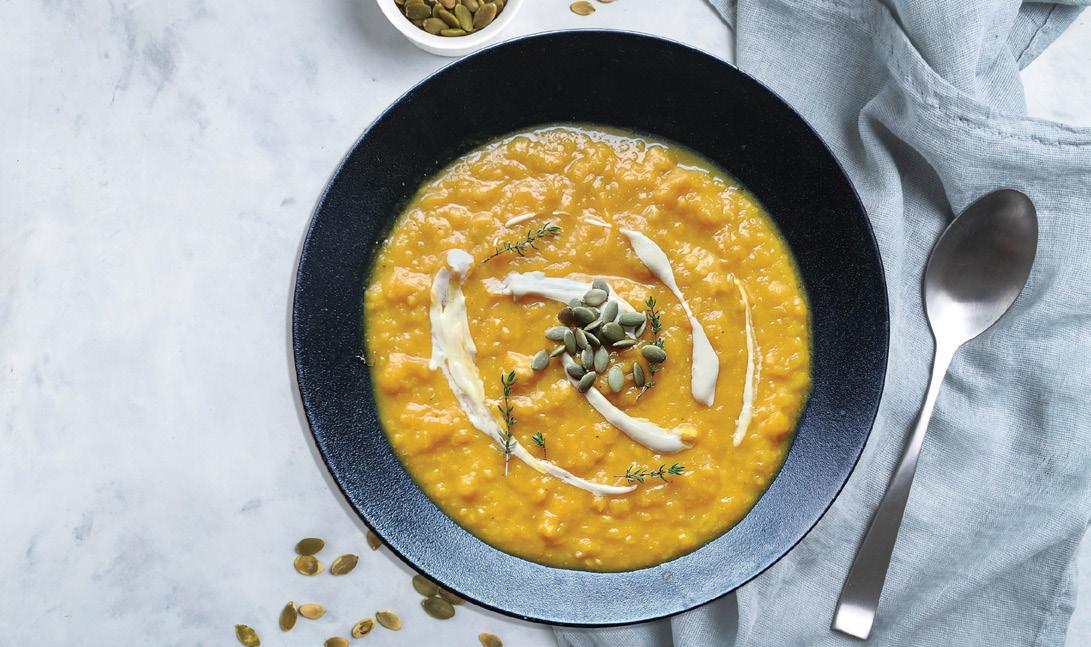
A warm winter soup that is quick to make but packed with flavour.
by Catherine Barclay | serves 41 1 2 1 can 1 tsp
2 Tbsp
2 cups 1 cup 1 tsp
whole pumpkin, cubed leek, sliced garlic cloves, minced chickpeas, drained moroccan spice miso paste vegetable stock water smoked paprika
1. Cut the pumpkin into cubes and roast at 180° C for one hour. Then, remove the lid for the last 20 mins to brown.
2. In a soup pot, saute the leek and garlic in a little water until the leeks are softened.
3. Add all other ingredients, boil, and simmer for five minutes.
4. Using a stick blender, pulse the soup until it smooths out the pumpkin but not to the point that all chickpeas are blended.
5. Served topped with a swirl of cashew cream.
1 cup cashews
1 cup water
Add both ingredients to a high speed blender and pulse until smooth.
CASHEW CREAMAfundamental principle of whole food plant-based eating centres on our ability to appreciate what, in nutrition speak, the concept of whole actually means. The WFPB use of the word whole has more to it than the consumption of the whole apple only.
For those that don't want to delve any deeper the 'whole apple only' explanation is a perfectly adequate definition which, when followed to the letter should result in generally good health, but there's one more step. You need to know that you can't automatically eat this way and expect to enjoy optimal health if you don't also eat a wide variety of foods. We call it, eating the rainbow - eat as wide a range of coloured fruits, vegetables, nuts, seeds, legumes as you can and don't hold back on the starches.
As always though, the detail can be much more complicated, especially when the nutritionists step in. Suddenly the health of anything can only be explained by understanding the detail of its parts.
For example, if a fruit is found to contain vitamin C, and vitamin C is identified as important to human health, then that ingredient has a stand alone value bigger than the whole, even though it is only a part. If this is true, then you must be able to split it off and recreate it as a supplement and that too, must be good for you, perhaps even better than the full apple, right? Unfortunately the answer to this is a very definite no.
The reductionist view
Dr T Colin Campbell sees this as a 'reductionist versus whole' view of science and, in his book Whole, he explains it this way:
"The reductionist mind cannot see the apple as promoting health and leave it at that. If apples are good for us, it can’t be the whole apple. There must be some tiny part of the apple, some chemical inside the apple, that is responsible for its beneficial effects. And our job is to extract that thing from the apple and figure out exactly how much of it people need on a daily basis.
"Under the reductionist mindset, healthy eating becomes a crapshoot of nutrient micromanagement—a list of individual nutrients that must be consumed in specific, regimented quantities. But in nature, you don’t find beta-carotene on its own. You can’t cut a slice of beta-carotene out of a carrot.
"Unfortunately, that doesn’t stop the supplement industry from trying."
Campbell doesn’t pull any punches when it comes to the efficacy of supplements. In fact, he says, the entire industry is founded on "the techno-fantasy that we can get all our nutritional needs met by powders, pills, or cubes, this industry has been relentless in analyzing foods known to promote health so it can extract and synthesize their active agents.
“We’ve already seen how the medical community treats disease with individual chemicals synthesized or isolated from
their natural origins."
He says the natural medicine and pharmaceutical industries do the same thing although, he suggests, the supplement industry has been “more effective in spreading its propaganda than the pharmaceutical industry."
And, "when the findings of a large number of studies are collectively evaluated, there is little or no evidence that routine vitamin supplementation improves health. Researchers have looked long and hard, in vain and using lots of money, for verifiable reductions in cardiovascular disease,1 cancer,2 and total mortality3 as a result of supplementation. Some of the best studies show that not only is reductionist supplementation not beneficial, it can actually be harmful."
As Campbell views it, the reductionist case for supplementation completely under estimates the “complexity of nutrition” – that “sometimes a combination of nutrients is more (or less) than the sum of its parts" and that the body determines how many nutrients from the food we consume are indeed used. Apples provide an excellent example.
"It is now clear," he says, "that there are hundreds if not thousands of chemicals in apples, each of which, in turn, may affect thousands of reactions and metabolic systems.4 This enormous number and concentration of vitamin C–like chemicals in apples poses a serious challenge to the notion that a single chemical—vitamin C or anything else—is responsible for the major health-giving properties of apples."

"In nature, you don’t find beta-carotene on its own. You can’t cut a slice of beta-carotene out of a carrot." T. Colin Campbell.
When it comes to planting vegetable seeds during the winter season, there are several excellent options that can thrive in colder temperatures. While many plants may lie dormant or struggle in the chilly weather, certain seeds are well-suited to withstand a frost and yield a bountiful harvest. Here are some recommended vegetable seeds to consider.

1. Beet Seeds: Beetroot can be sown direct and are pretty fast growing, typically being ready at 3 months similar to radishes. They sprout into vibrant beet plants, offering a range of culinary possibilities.
2. Kale Seeds: Kale is a hardy leafy green that can endure chilly conditions, making it an ideal choice for winter planting. It is packed with vitamins, minerals, and antioxidants. Plant kale seeds in autumn, and they will continue to grow throughout the winter, providing a fresh and healthy addition to your meals.
3. Spinach Seeds: Spinach is another cold-tolerant leafy green that thrives in winter. Rich in iron, calcium, and vitamins A and C, spinach is a nutritious addition to any garden. There’s still time left in warmer areas to sow these seeds. You will receive successive harvests of tender leaves throughout the winter.
4. Radish Seeds: Radishes are fast-growing root vegetables well-suited for winter planting. They prefer cooler temperatures and can mature quickly, allowing you to enjoy their crisp and peppery flavors within a few weeks of sowing. Ease of cultivation makes radishes ideal for beginner gardeners.
5. Garlic Seeds: While not technically seeds, garlic cloves can be planted in the winter for a summer harvest. Garlic requires a period of cold dormancy to develop large bulbs. Plant individual cloves in well-drained soil, and they will establish roots over the winter months. By the following summer, you will have mature garlic bulbs ready for harvesting.
6. Carrot Seeds: Carrots can be grown throughout the winter in milder climates or with the aid of protective coverings in colder regions. These crunchy and vibrant root vegetables are rich in vitamins and add sweetness to various dishes. Sow carrot seeds in well-prepared soil, and they will steadily grow throughout the winter, providing a fresh supply.
7. Pea Seeds: Certain varieties of peas, such as snow peas and sugar snap peas, can be planted in late autumn for an
early spring harvest. These legumes can withstand cold temperatures and continue to grow during mild winter periods. Peas enrich the soil with nitrogen and offer a delicious addition to stir-fries and salads.
When planting ve seeds during winter, it's essential to provide adequate protection for the young plants, especially during extreme cold spells. Consider using row covers, cloches, or cold frames to shield them from frost and provide additional insulation.
We offer heritage vegetable, herb and flower seeds to grow your own gourmet garden. Valid
An irresistible dinner – crispy fries topped with a simple homemade veggie chilli and cheesy sauce by Janice Carter - Lifestyle Medicine Coach | serves 4
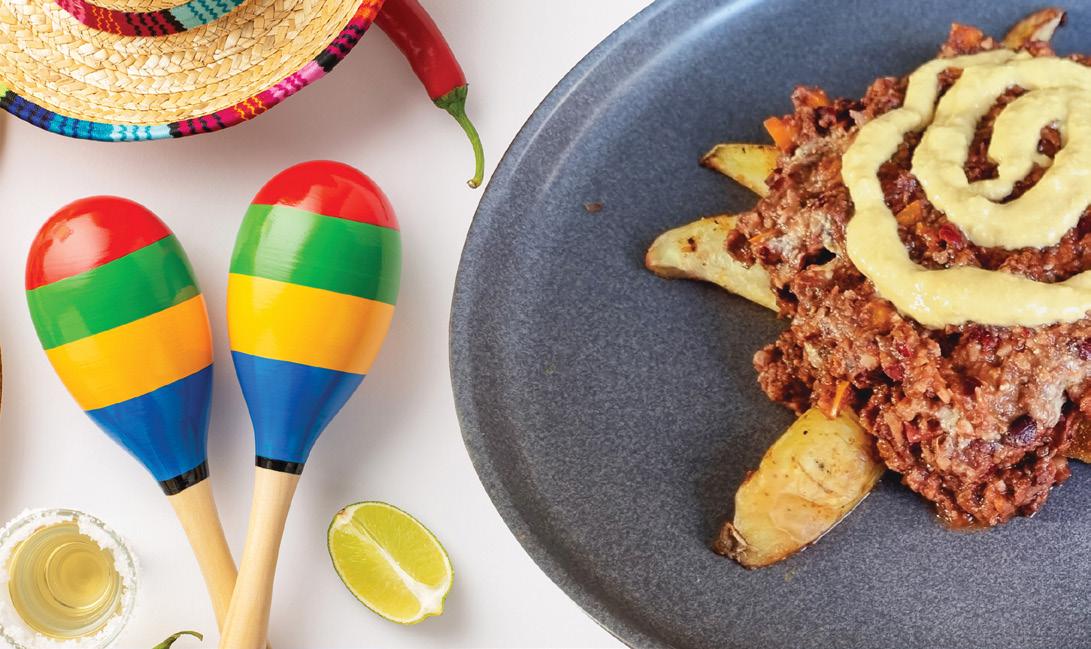
6 1/2 cup
400 gm tin
1
5
400 gm tin
2 Tbsp
1 1/2 tsp
1/2 tsp
1/8 tsp
potatoes, cut into wedges
walnut halves
red kidney beans
yellow capsicum, chopped
medium mushrooms, chopped
diced tomatoes
tomato paste
smoked paprika
ground cumin
cayenne pepper
Blend until very smooth:
½ cup cashews
1 tsp salt
¼ cup savoury yeast flakes
1/3 cup yellow capsicum finely chopped
2 Tbs lemon juice
¼ cup sunflower seeds
¾ cup water
1 tsp onion powder
½ tsp garlic powder
3 Tbs Tahini
1. Wash the potatoes, cut into chips and lay them out in a single layer on a couple of baking trays. Season generously. Bake at 190°C for about 30 minutes or until golden brown and crispy.
2. Meanwhile, add the walnuts, kidney beans, chopped pepper, and mushrooms to a food processor, and pulse a few times. You want to end up with a coarse mince - don't allow it to become completely smooth, but you don't want too many large chunks to remain either. You may need to stop and scrape down the sides a couple of times before pulsing the food processor another few times.
3. Transfer the bean mixture to a saucepan, and add the tin of tomatoes, tomato puree, and spices. Bring to a gentle simmer, and allow to cook for around 10 minutes, stirring regularly, until the mixture has darkened to become a richer colour.
4. Pile the cooked chips up on one baking tray, and spoon the chilli over the top. Finish by pouring the cheesy sauce over and top with your choice of toppings.
A creamy casserole for the cooler weather, snug up and enjoy. by
Catherine Barclay|serves 4
1 cup 1 med 450 gms
1 tsp
1 tsp 4
2 Tbsp
2 Tbsp
2 tsp
1 Tbsp
3 cups
450 gms
2 cans
2 cups
cashew cream (see p41)
brown onion, diced
button mushrooms, sliced
dried thyme
dried rosemary
garlic cloves, minced
nutritional yeast
cornflour
lite soy sauce
dijon mustard
vegetable stock
baby potatoes, halved
butter beans
plant-based milk
1. Add a little stock to a large stockpot or dutch oven, add onion and garlic, and saute until onion is translucent.
2. Next, add the mushrooms and herbs. Add more stock if required. Cook for 10 mins.
3. Take a 1/4 cup of the stock and stir in the cornflour to dessolve. Add to the pot along with the potatoes, mustard, and soy sauce. Bring to a boil, reduce the heat and simmer with the lid off for 15 mins.
4. Stir in the beans and milk, and continue to simmer for 15 mins or until the potato is soft.
5. Stir through the cashew cream.
6. Serve warm with your choice of greens.
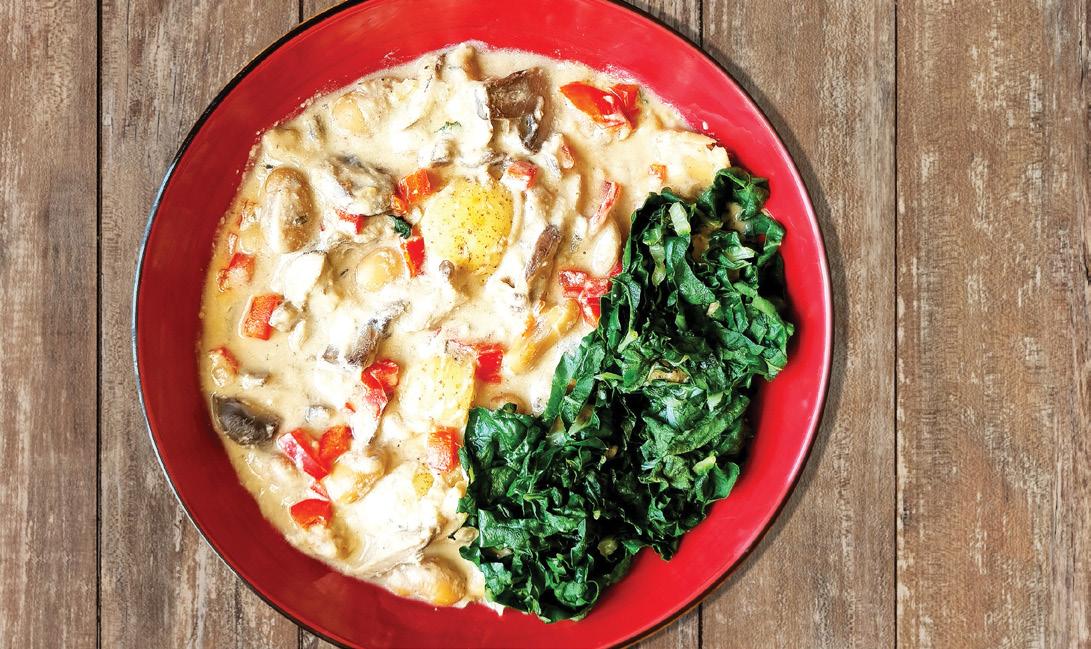
There are a number of expressions used within the programme of Alcoholics Anonymous that may ease the journey for those struggling to change their diet. As with the AA programme itself of course, they don’t come with a written guarantee but, taken together and used with an open mind, they have been found to work when you work at it.
Before I get into the nuts and bolts, it’s probably best I declare that I am a member of AA and have been a regular attendee of its meetings in person and more recently online, since August 28, 1986. Since that day, I haven’t taken a drink of alcohol, or a mind-changing drug. As we say in AA, that was my first day sober.
With an article like this, it’s hard to pick the ideal starting point because, well, I'm talking about food mostly and maybe a little about alcohol, but there is one expression that provides an opener.
In AA this means dealing with what matters most. Not drinking, for an AA, is the obvious one but in the broader sense, it is also a reminder that you need to put the thing you want to change most at the top of your priority list.
If it's food, you could say to yourself: 'I have changed, I will change what I eat today.'
A step like this can help you overcome that voice in your head that keeps repeating; you must be joking, the food sucks, why did I make this stupid decision anyway? AA's call that, 'the committee meeting in your head'.
In AA, it is believed, you have to stop what you are doing before you can change the way you think. This gives rise to the expression It’s Only the Action that Counts. You can think anything you like but it only counts when you take the action.
Usually, in the beginning, at least, this saying often revolves around negative thoughts but as time moves on it’s easy to see how it relates to positive thoughts and actions as well. In the food sense, for instance, it might relate to a desire to find out more about this way of eating or different recipes you can make but – just thinking about it doesn’t make it happen.
It’s an absolute fact that no matter what we want to do, we can only ever do something about it one day at a time. We can make plans for tomorrow and beyond, but when it comes down to it, we can only ever do something about it today.
This is a headspace saying. For AAs, it helps members to avoid becoming trapped in what we call, the two eternities, yesterday and tomorrow. With alcohol and even with food, especially if we’re being ‘forced’ to do something about our eating because of a serious medical event or a recent blood test result, we can fall into negative thinking. AAs call it, stinking thinking. It's unproductive and leads to inaction.
When I was in hospital after my stroke, I began pondering, why me? Why should this happen to me? Such thoughts can lead
you to thoughts like ‘I wish I’d kept my drinking (or eating) under control but if you can truly get your mindset into the One Day at a Time philosophy it makes yesterday history and tomorrow a mystery. That leaves you with only one day in which you can anything about whatever it is that bothers you.
A key factor that needs to be stressed here is that if you stop drinking you won’t die but if you stop eating, you will. The AA programme was developed by two people who were desperate to stop drinking and stay stopped. But how do you handle it when you need to keep eating?
It’s important to think about what you have been doing and ask yourself, why?
In the alcohol sense, this could involve a real world event like, 'I went out to see Mary but I came home with John. Why?' Well, the details are much less sordid than what you might think.
The fact is, Bob went out to see Mary, thought he’d stop in for a quick one on the way but ran into his old mate John. They had a lot of catching up to do. John loved fishing and Bob had just sorted the boat out for the season. John said: 'the weather looks corker tomorrow.' So, after a few more at the bar they pick up some takeaways (more alcohol that is) and head home to pack up the boat. The drinking continues through the night and ‘with the sun poking its nose over the yard arm’ they head down to the jetty and out to sea.
Later, Mary calls up with some awkward questions like, why and where were you? He says; 'John made me do it.'
Now, without delving into this scenario too deeply and before we start apportioning blame, (heaven forbid we’re all too PC for that these days), perhaps we can accept that there’s something wrong with someone’s thinking here.
In AA we say, it’s your thinking that’s wrong and, if a newcomer asks; 'well how much of my thinking is wrong?' We usually respond with, 'all of it.' When it comes to a drastic dietary change, something we face something similar.
What you are embarking on here is not just a matter of decorating your plate with plants, it's a paradigm shift and you need to think about it - but maybe not too much or for too long, especially if your doctor has strongly advised that change would be a good idea. You will also need to learn as much as you can about it because that will help you understand why.
With food, as in AA, we may never understand everything there is to know. AA’s earnest recommendation in such circumstances is to Hand it Over. Sometimes the answer comes with time, sometimes not.
Without going into it in depth, this area refers to spiritual matters. AA mantra holds that all our problems fall into three categories: physical, mental and spiritual. I think the simplest explanation I’ve heard for the spiritual part, at least one that worked for me at the time, is to think about why you may feel
“It all depends on how we look at things and not how they are themselves,” Carl Jung
Mary! Ah, no ... well I was on my way but John dropped in and guess what! Hmm ... so how was the birthday?
better when you talk a problem over with someone who cares.
For some reason, you feel better, but why? The physical circumstances may not have changed, you may mentally feel better but it’s not because something physical was implanted in your head. For some inexplicable reason, you just feel better. Something similar happens when you walk out on a beach, trek through a forest, dive deep into the ocean or stand amidst mountains.
All this relates to what we now refer to as our overall wellbeing It’s the now undisputed fact that good health involves much more than a bike ride or what we put on our plates, although they are essential elements to the whole.
We refer to whole food plant-based eating as a lifestyle change because it forces us to confront some of our most basic beliefs. Just like giving up alcohol, it’s a paradigm shift because we are ultimately faced with changing much of our thinking as well. And there’s a certain level of sacrifice and personal criticism attached to it as well.
As time moves on though, just like with any surviving AA, there are new friends to be made and amazing new taste sensations to discover and enjoy.
Sadly however, I'd like to say that my fellow AAs are all called to embark on a similar journey but that's not the case. Many of them don't view their AA discovery as part of a broader health journey and, in my experience, still die of lifestyle illnesses at an appalling rate.
This, for me, is one of the great AA sayings and the one that turned me on to discovering what whole food plant-based eating was all about. Previously I was just playing with it thinking that if I ate a bit of chicken or a piece of fish here and there, what difference would it make? For me, the reality was, not a lot, and my blood tests showed it.
There was also a mindset shift because I had to ask myself why was it that all the doctors tied up with this thing were so adamant that it should be a diet with no sugar, salt or oil. The

answer is, because that’s what all the research proves and it’s the only way they can honestly recommend it.
One thing many AAs struggle with (me includeded) is when we go to a group event where alcohol is being served and a well meaning host says something like, 'oh, look I know you can't drink alcohol so I've made sure there are some pop drinks for you over there.' usually where the children's cakes and the plastic glasses are.
A key factor in the AA programme lays in understanding its element of choice. Even though I don't drink alcohol, I don't want you to go to great length to hide it away because that takes away my right to choose. To set myself free of the alcohol mindset though I had to stop drinking it - you have to learn to live without it before you can live with it. Something similar applies to the WFPB way of eating and that's why I'm such a firm advocate for going 'the whole hog' so to speak, right from the outset.
But you know, you can still eat it any way you like. If you take that path though, don’t expect to easily achieve all the good things WFPB eating has to give, or even any of them for that matter.
Personally, I can’t say I’ve stopped drinking if I move from beer to whiskey or don’t drink during the week but lash out on Saturday night. The choices are perhaps a little more open with WFPB eating but that depends on your why. If you're doing it for the animals there is no choice, if you're doing it for your health, why would would you not change now and if we were all serious about doing it for the planet, we should have changed years ago.
Maybe this is where the comparison between food and alcohol splits completely but it’s also the point where another AA expression applies. In the AA sense, Progress not Perfection, relates more to personal/spiritual change but with food, we don’t have to be perfect, in fact, it’s virtually impossible to do so.
On any given day, in AA terms, the only ‘perfect’ thing I can do is not drink but where my WFPB lifestyle is concerned, I can only ever be a work in progress.

Cashew based sauce, delicious on scrambled tofu, asparagus and roasted vegetables. by Catherine Barclay | serves 6
INGREDIENTS
1 cup
1 Tbsp
1 Tbsp 1/2 tsp
1/2 tsp
1 tsp
6 Tbsp
3/4 cup
1/2 tsp
cashews
nutritional yeast
dijon mustard
turmeric powder
black salt - kala namak
miso
lemon juice
water
black pepper, to release the benefits of the turmeric
METHOD
Combine all ingredients in a high-speed blender. Add more water if the sauce doesn't run smoothly.
Tahini based sauce super easy to make great on warm vegetable salad. by Catherine Barclay | serves 12
INGREDIENTS
3/4 cup
1 Tbsp 2 1 tsp 1 cup
1/2 cup
1/2 tsp
tahini dried dill
garlic cloves
maple syrup
water
lemon juice
black pepper
METHOD
Combine all ingredients in a high-speed blender. Add more water if the sauce doesn't run smoothly.
Much more flavour than your average, store-bought American mustard. It has a lot of kick so play with the mustard seed powder to achieve your preferred taste.
by Catherine BarclayINGREDIENTS
1/3 cup 1/4 cup
1/4 cuo
1/8 tsp
1/8 tsp
1/8 tsp
yellow mustard seeds
water
apple cider vinegar
ground turmeric
garlic powder
ground sweet paprika
black pepper, to release the benefits of the turmeric
METHOD
1. Using a coffee grinder, blitz the yellow mustard seeds until it is a smooth powder. If you don't have a coffee grinder, use store- bought mustard powder.
2. Add all ingredients to a small saucepan and whisk until smooth.
3. Bring to a slow boil over medium heat. Boil for 8 mins, stirring regularly to avoid sticking to the pan.
4. Allow to cool, then cover and cure for up to 10 hours before moving to a sterilised jar.
These days, few of us doubt the long-term dangers of cigarette smoking. We understand the damage it causes isn't immediately apparent but accumulates over time. Something similar happens with food, but why don't we think that way when we go shopping? Science has now proven that today's lifestyle illnesses are clearly linked to the food we eat. Think about it the next time you go shopping. All the diseases listed below are on offer; it's just a question of what you put in your trolley.
Heart Disease
Bowel Cancer
Crohn's Disease
Asthma
Multiple Sclerosis
Irritable Bowel Syndrome
Type 2 Diabetes
Alzhiemers
Acne
Breast Cancer
Ulcerative Colitis
Prostate Cancer
Osteoporosis
Inflammatory Arthritis
Constipation
Diverticulitis
Menstral Pain
Ovarian Syndrome

Diverticulitis is a condition characterized by inflammation or infection of small pouches, called diverticula, that form in the lining of the digestive tract, primarily in the colon. These pouches develop when weak areas of the intestinal wall bulge outward, forming small sacs. When these diverticula become inflamed or infected, it leads to diverticulitis.

The exact cause of diverticulitis is not fully understood, but it is believed to be associated with a combination of factors, including a low-fiber diet, aging, obesity, and a sedentary lifestyle. When a diverticulum becomes blocked by stool or bacteria, it can lead to infection and inflammation, resulting in diverticulitis.
Diverticulitis can cause various problems and symptoms. Mild cases may present with abdominal pain, primarily on the left side, along with bloating, cramping, and changes in bowel habits.
More severe cases can involve persistent and intense
pain, fever, nausea, vomiting, and rectal bleeding. In some instances, complications can arise, such as abscess formation, perforation of the colon, or the development of fistulas, which are abnormal connections between different parts of the intestine or other organs.
These complications can lead to further health problems, including severe infections, peritonitis (inflammation of the abdominal lining), bowel obstruction, or even sepsis, a lifethreatening condition. Prompt medical attention is crucial to diagnose diverticulitis accurately and initiate appropriate treatment, which often involves antibiotics to clear the infection, pain management, and dietary modifications.
Long-term complications of diverticulitis can include recurrent episodes of inflammation, chronic pain, and the formation of scar tissue that may lead to strictures or narrowing of the colon. In rare cases, surgery may be necessary to remove the affected portion of the colon if the condition becomes chronic or if complications arise.
Preventing diverticulitis involves adopting a balanced lifestyle and making specific dietary and lifestyle choices.
Firstly, maintaining a high-fiber diet is crucial.
Consuming ample fruits, vegetables, whole grains, and legumes helps promote regular bowel movements and reduces the risk of diverticula formation. Staying hydrated by drinking an adequate amount of water is also essential for bowel health. Regular exercise plays a vital role in preventing diverticulitis, as it aids digestion and maintains bowel regularity.
Moreover, managing stress levels is important, as chronic
stress can contribute to digestive issues. Adopting stressreduction techniques like meditation or engaging in activities you enjoy can be beneficial. Additionally, avoiding smoking and excessive alcohol consumption is advised, as they can irritate the digestive system and increase the risk of diverticulitis.
In summary, preventing diverticulitis involves a combination of factors such as a high-fiber diet, proper hydration, regular exercise, stress management, and avoiding harmful habits like smoking and excessive alcohol intake. It is important to consult with a healthcare professional for personalized advice and recommendations.

"Genetics load the gun, lifestyle pulls the trigger."
Dr Caldwell Esselstyn
Very quick to prepare and served with brown basmati rice, a very hearty winter meal. by Catherine Barclay | serves 4

450 gms
1 sml knob
1 sml knob 1 1 tsp 1 tsp 1 tsp 2
1 tsp
1/4 tsp
1 can
baby potatoes, halved
fresh turmeric, grated
fresh ginger, grated
red onion, sliced
cumin seeds
mustard seeds
curry powder
cloves garlic, minced
garam masala
chilli powder
crushed tomatoes
baby spinach
1. Pre-boil potatoes for 10 mins until tender.
2. Grind cumin and mustard seeds in an electric coffee grinder, mortar, and pestle.
3. Add ground seeds to a frying pan with onions, garlic and potato, with a little water and dry fry for 5-7 mins.
4. Add curry powder, turmeric, ginger and chilli and mix through to heat. Grind in some pepper to release the benefits of the turmeric.
5. Pour in the tinned tomato and cook for 10 mins. Stir through the garam masala.
6. Lastly, add the spinach and allow it to wilt into the dish mixing it through slowly.
Serve on a bed of brown basmati rice.
1
3 Tbsp
2 tsp
1/2 tsp
One of the many things you can use the air fryer for is to make pineapple zing. Play around with this combination of flavours. by Catherine Barclay | serves 2
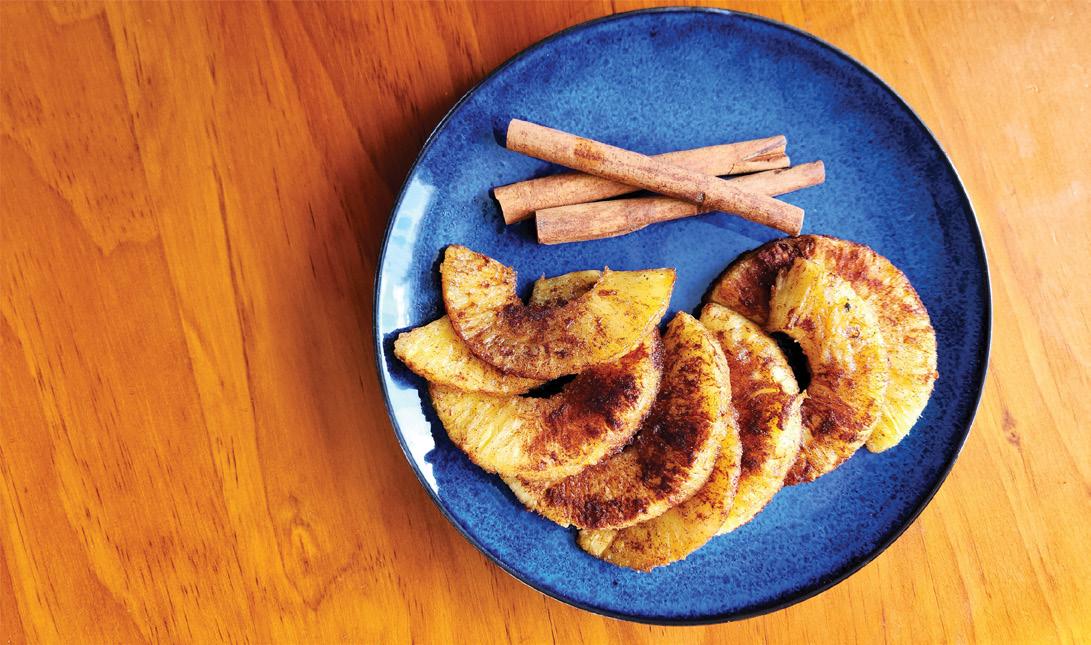
pineapple, peeled, cored & cut into halves
maple syrup
ground cinnamon
ground cardamom
1. In a small bowl, mix the cinnamon and the cardamom.
2. Place pineapple into a medium-sized bowl. Pour over the maple syrup, then sprinkle on half the mixed spices. Gently turn over the pineapple and sprinkle on the remaining spices.
3. Gently move the pineapple into the air fryer basket.
4. Airfry the pineapple at 200°C for 10 mins.
5. Serve warm.
The process of creating cultivated meat is similar to brewing beer, but instead of growing yeast or microbes, cells from livestock are multiplied in the lab. Under anaesthetic a .5 gram segment, approximately the size of a peppercorn, is taken.
From here the real 'magic' happens under highly controlled conditions, according to Netherlands based Mosa Meats. From one biopsy as many as 33,000 myosatellite cells can be developed, enough to produce up to 80,000 burger patties.
The future development of lab meats was discussed at a co-sponsored CNN health event in June last year and was also the subject of a recent article where lab meat producers were positively showcased as potential environmental saviours and the ethical answer to animal cruelty.
At this point, most of the lab meat companies are still working on scaling up production. Of course, as the problem of scale is solved so does the challenge to traditional animal farming increase. By 2030 Israel-based Believer Meats (formerly Future Meat Technologies) expects to produce burger patties for around $2.30 to $4.50 apiece.

On December 7 last year, Believer broke ground on the largest cultivated meat production facility in the world with its first commercial premises based in Wilson, North Carolina. Once operational, the company says, this 18,580 square metre facility will have the capacity to produce at least 10,000 metric tons of cultivated meat annually and will cover their needs for decades to come.
Its state-of-the-art facility will feature an R&D and innovation centre, a contemporary kitchen to host tastings, as well as offices and conference room spaces.
The jury is out on where the cultured meat market will go. Some traditional growers might argue that meat from a lab is just
meat from a lab - grass-fed Wagyu beef is completely different, or so the marketeers say. The issue here is not so much the debatable difference between the two but the price point.
When it comes to eating flesh, human beings are suckers not only for the cheap deal but the super expensive one as wellthink Fugu (puffer fish) in Japan for instance.
And then of course, what about human flesh? Yes, it has actually been discussed!1 Even T. Colin Campbell in his book The China Study, notes that human flesh is the most efficient provider of "the building blocks for our replacement proteins," but, he goes to great lengths to prove why plants are still better for us.
Still, if you can get yourself over the "absolutely yuk factor" it might only depend on what a lab meat company sees as a worthy commercial opportunity and what you are prepared to pay to put a piece of Kim Kardashian on your plate. - Peter Barclay
across Southeast Asia in early May sent records tumbling as the region sweltered under a week-long furnace that brought misery to millions.
All-time highs were recorded in Vietnam, Laos and the Thai capital Bangkok, where the heat was compounded by an intense smoggy season that caused pollution levels to spike.
Scientists have long warned that heat waves are set to get worse as the impacts of the human-caused climate crisis accelerate.
In Vietnam, temperatures reached 44.2 degrees Celsius (around 111.6 Fahrenheit) in the northern district of Tuong Duongthe highest temperature ever recorded in the country.
In neighbouring Laos, the city of Luang Prabang hit 43.5 degrees Celsius
(110.3 Fahrenheit), breaking the national record of 42.7 degrees Celsius (108.9 Fahrenheit) set last month. The Laotian capital Vientiane also broke its all-time record with a temperature of 42.5 degrees Celsius (108.5 Fahrenheit).
Meanwhile, Thailand, saw its hottest ever temperature recorded in Bangkok41 degrees Celsius (105.8 Fahrenheit).
A 2022 study found that dangerous heat waves, in the order of 39.4 degrees Celsius and above, will occur between three and 10 times more often by the turn of the century.
In the tropics, which includes much of Asia, the study found that days of "extremely dangerous heat" - defined as 51 degrees Celsius - could double, putting the population of impacted countries at risk.
"We don't know what could happen
if large populations are exposed to unprecedented heat and humidity stress," the study's lead author Lucas Vargas Zeppetello from Harvard University told CNN, "but heat waves in the past few decades have already been extremely deadly and there is serious cause for concern in the future."
The developing Asian situation is also expected to have repercussions for countries like Australia and New Zealand.
Atmospheric rivers usually begin over tropical regions where warm temperatures cause ocean water to evaporate and rise into the atmosphere.
Strong winds help to carry large amounts of water vapour through the atmosphere. As atmospheric rivers move over land, the water vapour inside keeps rising. It suddenly cools and drops as a deluge that can be locally devastating.
The World Health Organization (WHO) has released a new guideline on non-sugar sweeteners, which recommends against their use to control body weight or reduce the risk of noncommunicable diseases.
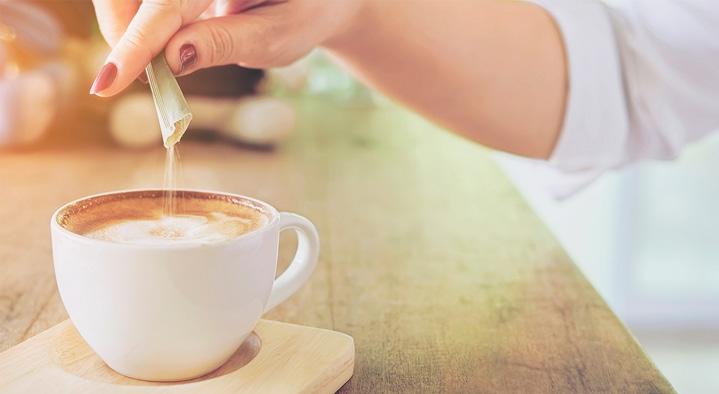
The recommendation is based on the findings of a systematic review of the available evidence which suggests that use of non-sugar sweetners (NSS) does not confer any long-term benefit in reducing body fat in adults or children. Results of the review also suggest that there may be potential undesirable effects from long-term use of NSS, such as an increased risk of type 2 diabetes, cardiovascular diseases, and mortality in adults.
"Replacing free sugars with NSS does not help with weight control in the long term. People need to consider other ways to reduce free sugars intake, such as consuming food with naturally occurring sugars, like fruit, or unsweetened food and beverages,” says Francesco Branca, WHO Director for Nutrition and Food Safety.
"NSS are not essential dietary factors and have no nutritional value. People should reduce the sweetness of the diet altogether, starting early in life, to improve their health."
The recommendation applies to all people except individuals with preexisting diabetes and includes all synthetic and naturally occurring or modified
non-nutritive sweeteners that are not classified as sugars found in manufactured foods and beverages, or sold on their own to be added to foods and beverages by consumers. Common NSS include acesulfame K, aspartame, advantame, cyclamates, neotame, saccharin, sucralose, stevia and stevia derivatives.
The recommendation does not apply to personal care and hygiene products containing NSS, such as toothpaste, skin cream, and medications, or to low-calorie sugars and sugar alcohols (polyols), which are sugars or sugar derivatives containing calories and are therefore not considered NSS.
Because the link observed in the evidence between NSS and disease outcomes might be confounded by baseline characteristics of study participants and complicated patterns of NSS use, the recommendation has been assessed as conditional, following WHO processes for developing guidelines.
This signals that policy decisions based on this recommendation may require substantive discussion in specific country contexts, linked for example to the extent of consumption in different age groups.
The WHO guideline on NSS is part of a suite of existing and forthcoming guidelines on healthy diets that aim to establish lifelong healthy eating habits, improve dietary quality and decrease the risk of NCDs worldwide.
Ajoint Government and New Zealand Steel announcement late last month was good news for climate change which is becoming an increasingly sensitive subject in Aotearoa as the country recovers from a series of brutal and very costly downpours over summer.
The company is to build a new $300M Electric Arc Furnace at its steelworks at Glenbrook within the next three years in a $140M partnership that will significantly lower the country’s carbon footprint. The reduction is so large that it would equate to the removal of all 300,000 cars from the city of Christchurch.
The new plant will stop 800,000 tons of carbon from being released into the atmosphere. Nationally, it equates to a one per cent reduction in NZ’s current total carbon emissions.
It's a reduction of over 45 per cent in New Zealand Steel’s emissions, says company CEO Robin Davies and also sets the platform for further carbon reductions. "It is a significant step towards our goal of net zero by 2050."
The reductions will come from replacing Glenbrook’s existing oxygen steelmaking furnace and two of its four coal fuelled kilns.
“An electric arc furnace makes sense when there’s enough affordable renewable energy and scrap steel available, a way to get that scrap steel to site, and the right policy settings. We’ll firm up the details of the different aspects of the project over the coming months," Davies said.

New plant a big carbon bonus

In the words of Jessica, the creator of these amazing balls ... "The fastest & most delicious snack you will ever make!"
by Jessica Lamb - Instagram @plantbasedecowarrior | makes 12INGREDIENTS
2 cups
rolled oats
2
1 cup
2 tsp
ripe bananas dates (soak in boiling water & drain)
cinnamon
Jessica's top tips on going plant-based
1. Choose your favourite meals and veganise it. For example, if you love butter chicken, use chickpeas instead of chicken. If you love nachos, use lentils and beans instead of mince.
2. Using spices is super important! Some plants, although they are really good for you, are just
Whiz all ingredients in a food processor. Roll into balls, freeze, and you’re done
Best left in the fridge.
really bland. Adding spices when you cook them really helps to boost the flavour and will make you love eating plants! My favourite spice is cumin and I literally add it to everything!
3. An easy swap is changing milk for plant based milk. These are available in supermarkets, but are also very simple and cheap to make. I make my own oat milk and it only takes 5 minutes!

A remake of the sticky lemon muffins we used to make before going plant-based. by
Catherine Barclay | makes 121 cup
1/2 cup
1 tsp
1 Tbsp
2 cups
2 tsp
1/4 tsp
1/2 cup
1/4 cup
plant milk (I used soy)
maple syrup
vanilla extract
ground linseed (flaxseed)
whole wheat flour
baking powder
baking soda
apple sauce
lemon juice
zest one lemon
1. Preheat oven to 180°C (350°F)
2. Mix the ground linseed with the plant milk, then add all ingredients to a large bowl.
3. Fold over the mixture gently until combined, don't over mix.
4. Evenly spoon the mixture into a silicon muffin tray or disposable cake cups.
5. Bake for 30 mins.
6. Add the below glaze to the muffins while they are still warm.
1/4 cup of lemon juice
2 Tbsp brown rice syrup or maple syrup
Mix the two ingredients and baste over the muffins while they are still warm. Keep repeating until the glaze is finished.
Whole Food Living has built to a solid resource base on plant-based eating. If you are missing backdate issues, or would like to gift some to a friend, then go to the link at right.
Please note, this offer is only available while stocks last.
By going through to our secure online checkout system you will receive a discount with the code.
Additional postage costs may apply to international orders.
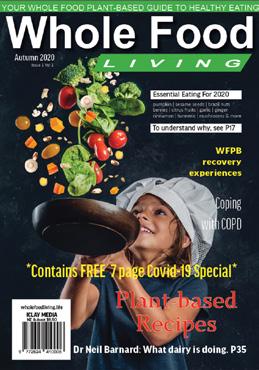





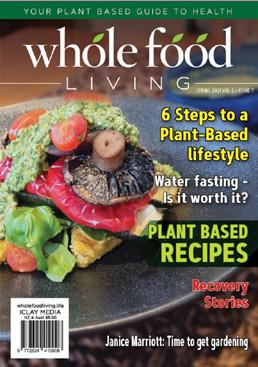


Run the cut side of a lemon over the board to remove food stains and smells. For extra cleaning power, sprinkle it with salt or baking soda first.
Need help eating nutritional yeast-flavoured popcorn, try adding balsamic vinegar to a spray bottle. Then, spray the popcorn to make the nutritional yeast stick.
Use your paper cupcake cups .. preheat oven to 190°C, and slice off the top of 12 garlic bulb heads enough to expose the garlic. Place the cups into muffin trays and add water to the paper cups. Place the garlic cut part downwards into the paper cups. Cover with aluminium foil and bake for 35-40 mins.
Keep your lemon peels when you have 6 - 8 lemons worth of peels. Place them on a tray and dry them in the sun or use a dehydrator. Once they are dry, blend until they form a fine powder. Mix with ground pepper and use to flavour chips or wedges.
A roll pizza cutter is wonderful for cutting herbs and greens, is quicker and safer than knives and stays sharper for longer.
Use ice cubes to freeze the extra vegetable stock, and pour them into the individual cubes. When frozen, move them to freezer bags, which are great for sauteing.

• 1 cup of oats
• 4 cups of water
• 1-2 dates (optional to make it sweeter)
Blend all ingredients for 30-40 seconds. Pour through a sieve, and you’re done!
@PLANTBASEDECOWARRIOR
If you love those gherkins, you will go through many jars. However, they can be a perfect uniform size for storing dried lentils, nuts, and beans. Once all the gherkins are gone, put them into your dishwasher, and then it will be easy to remove the label.

LED bulbs use significantly less energy than traditional incandescent bulbs, which means you can save up to 75% on your energy bill! Not only that, but LED bulbs last up to 25 times longer, which means you won't have to replace them as often.
Put your avocados in the freezer when they are at the proper ripeness. When they are ready to use, run it under warm water and leave it on your counter to thaw. You know when it is ready when you can press your finger into it.
Are you working from home more? Think about how you can connect with nature from home. Can you bring some nature indoors? Put up pictures of maunga (mountains), whenua (land), moana (oceans), or awa (rivers) that have meaning to you. Listen to nature sounds - birdsong is a lovely background noise while you work. Open the windows as often as you can. Take time daily to feel the sun, the wind, or the rain on your skin.
mentalhealth.org.nz
Never store onions with potatoes. It makes the onions go off more quickly.
GOT SOME GREAT TIPS TO SHARE?
CONTACT ME AT CATHERINE@WHOLEFOODLIVING.LIFE
The Podcast selections below cover food and health issues and provide quick access to a deeper understanding of what whole food eating can achieve. Listening to podcasts on a regular basis is a great way to increase your understanding of WFPB and keep yourself on track.


In her 2015 book, Design the Life You Love, Ayse



shows us how to apply the principles of good design to the biggest project we'll ever work on: our own lives.

PositivePsychology.com's Hugo Albert and Seph



talk about how can we reap the benefits of deep focus and end the day with a sense of achievement and fulfillment?
The YouTube selections below cover a range of lifestyle, food and health issues. They include specialist tips and easy access to a deeper understanding of what whole food plant-based eating can achieve.


Learn the secrets to achieving long-term success when adopting new wellness habits with Dr Darren Morton https://tinyurl.com/yc64a5wp


https://tinyurl.com/3k7xvaj2
Dr Steven Lome talks about how eating a plant based diet is a cure for heart disease.
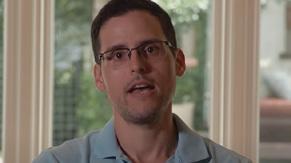
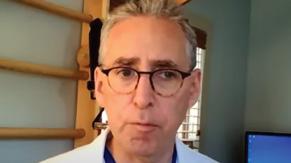


https://tinyurl.com/2ew8cpby
The health implications of our diet. Why everyone should consider a Plant Based diet - Mick Walker
https://tinyurl.com/kstjr57c
The Real Truth About Health talks to Dr's McDougall, Klaper and Edpinosa about body weight and health.

https://tinyurl.com/yc6r26hu
Multiple Sclerosis (MS) symptom management is key to living well with this disease.
https://tinyurl.com/yppxtnzt
https://tinyurl.com/eetczded
https://tinyurl.com/5n8mpjhe
Cone Health talks about patient Jonathan Todd who turned around his health issues with a plant-based diet. Chef AJ talks with Dr Ron Weiss on eating fibre, oatmeal for diabetics, and whether nuts raise LDL and more. In 2012 Adam Sud changed his life around after hitting rock bottom due to multiple forms of addictions.British family doctor Gemma Newman explores how a simple change in diet helps many common chronic illnesses - from diabetes and heart disease to obesity - and the science that explains why it works. Contains over 60 delicious meal ideas.

Lisle and Goldhamer offer unique insights into the factors that make us susceptible to dietary and lifestyle excesses and present ways to restore the biological processes designed by nature to keep us running at maximum efficiency and vitality.
T. Colin Campbell and his team at Cornell University, in partnership with teams in China and England, embarked upon the most comprehensive study ever undertaken of the relationship between diet and the risk of developing disease. Their results still astound.

Why rely on drugs and surgery to cure you of life-threatening disease when the right decisions prevent you from falling ill to begin with? How Not to Die gives effective, scientifically proven nutritional advice to prevent our biggest killers.

Suzy Amis Cameronenvironmental advocate, former actor, and mom of five, presents an easy guide for you to improve your health and shrink your personal carbon footprint. Just swap one meat- and dairy-based meal for a plant-based one.

From the groundbreaking results of his twenty-year nutritional study, Prevent and Reverse Heart Disease by Dr. Caldwell Esselstyn illustrates that a plantbased, oil-free diet not only prevents the progression of heart disease but can also reverse its effects.

The film's companion cookbook, The PlantPure Nation Cookbook brings a powerful, science-based approach to nutrition from the big screen to your kitchen with some of the same mouthwatering recipes that kick-started a revolution.

Dr Dean Ornish's research has proven that lifestyle changes can reverseundo! The progression of many of the most common and costly chronic diseases and even begin reversing ageing at a cellular level. Several insurance companies cover his programme.


Neal Barnard, MD, a leading authority on nutrition and health, offers insight into how dietary changes can alleviate years of stress, pain, and illness. What's more, he also includes delicious and easyto-make hormone-balancing recipes.

Sophie Steven's stunning cookbook is packed with over 100 delicious, vibrant plant-based, gluten-free and refined-sugar-free recipes. Some great recipes and taste sensations to try. A book that will benefit the whole family.

This is a book that will let you live longer, reduce your need for medications, and improve your health dramatically. It is a book that will change the way you want to eat. Follow the Eat to Live diet, you will lose weight faster than you ever thought possible.

Colin T Campell's Whole is an absolutely eye-opening, paradigm-changing journey through some cutting-edge thinking on nutrition. It is a scientific tour de force, that has powerful implications for our health and for the future of our world.

Want to eat healthily, but worried it will cost too much? Looking to save on grocery bills, without compromising on nutrition value or flavour? This book will answer all your questions. Great if you need to keep the food bill tight. Great inspiration here.

Before Dr Barnard's scientific breakthrough, most health professionals believed that once you developed diabetes, you were stuck with it. We know now that this is simply not true. Barnard has shown it is possible to tackle type 2 diabetes.

Rip Esselstyn arms readers with the knowledge they need to win any argument with those who doubt the health benefits of a plant-based diet and to convince any number of curious carnivores to change their diets once and for all.


Produced by Kiwi documentary filmmaker, Grant Dixon, this movie traces his efforts to discover why he wasn't told about problems with meat and dairy. If he'd known he could have saved himself a heart attack. He asks why he wasn't told about WFPB. On iTunes
Directed by Amy Taylor and presented by indigenous activist Chris Huriwai, MILKED has been racking up some massive viewing numbers worldwide. This Kiwi created doco takes a hard look at industrial dairy farming in New Zealand and shows how it 'milks' not only animals but farmers, consumers, rivers, the land and the climate. MILKED attacks the cynical marketing jargon used to hide the negative impacts of an industry many Kiwis have come to accept as one of the vital vertebras in the country's financial backbone. Available at: join.waterbear.com/milked

The seminal film of the WFPB movement that has impacted millions the world over. Forks over Knives examines the profound claim that most, if not all, of the chronic diseases that afflict us, can be controlled or even reversed by rejecting animal-based and processed foods. Available on Amazon & iTunes

A documentary film that follows several elite vegan athletes. It gives a broad overview of the benefits of plant-based eating and contains great personality interviews with people that have made the change. A must for all sports coaches. Available on Netflix

This film calls to attention the most popular diets on the planet and draws together several misconceptions about weight loss and nutrition. Filmmaker Michal Siewierski presents a punchy case and followed it up TakeOut. Bottom line message, go WFPB. View on Amazon.

A 2017 documentary film which critiques the health impact of meat, fish, eggs and dairy product consumption, and questions the practices of leading health and pharmaceutical organisations. Is there a conspiracy here? Check it out on Netflix.

Code Blue reveals lapses in the current state of medicine and provides a common sense solution by featuring the practise of lifestyle medicine to prevent, manage and reverse chronic diseases. It covers hurdles to such a change and looks at the barriers. View on Amazon.

Across
3. Snooze (6)
6. Use again p.27 (7)
8. Choose (3)
10. Sugar substitutes pg. 55 (9)
15. Kind of message pg.10 (9)
16. Type of cheese pg.21 (10)
17. The Southern ... (4)
19. In great numbers (6)
21. Period (4)
22. Conceal pg.38 (10)
23. Stainless steel food mill (5)
24. Soy bean curd pg.37 (4)
25. Heritage seed company pg.43 (4,5)
28. Coating (6)
29. Creamy sauce pg.49 (10)
31. Type of tree (5)
33. Pure joy (5)
35. Be ahead of (7)
36. Wager (3)
Down
1. Extends lease (6)
2. Star sign (3)
3. Chemotherapy p.30 (5)
4. Convent dweller (3)
5. Progress, not ... p.47 (10)

7. Vegetable p.24 (11)
9. Soup pg.29 (6)
11. Pull, tear (4)
12. Standard of measurement (5)
13. Labels (5)
14. ... Wellness pg.14 (4)
16. Dr Darren ... pg.10 (6)
18. Best in a race (6)
20. Open savoury tart pg.37 (6)
23. Small cakes pg.57 (7)
26. Not this or that (5)
27. Dr ... Koelmeyer pg.18 (5)
30. Embrassing (7)
32. Coagulated soy (4)
34. Frozen water (3)
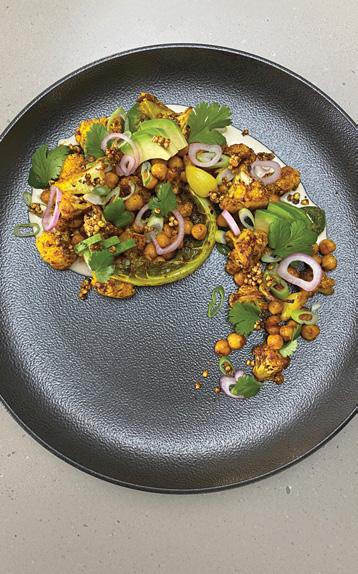




Based on the guide developed by PCRM (Physicians Committee for Responsible Medicine) in 1991

3 or more servings a day
Full of vitamin C and beta carotene, fruit is also rich in fibre. You should include at least one serving of fruit per day. Fruits are full of flavour, make a welcome afternoon filler and are great as a night time desert. They're best eaten whole because your gut benefits from their soft fibre.
Serving sizes: 1 medium piece of fruit, 1/2 cup cooked fruit, 4 ounces juice.
5 or more servings a day
The wholegrain list is large. Here is a sample: barley, freekeh, whole rye, brown rice, oats, wheat, buckwheat, bulgur, quinoa, whole wheat couscous, corn, millet. Build meals around hearty grain dishes. They’re rich in essential fibre, complex carbohydrates, protein, B Vitamins and zinc. Great for breakfast.


Serving sizes: 1/2 cup hot cereal, 1/4 cup dry cereal, 1 slice bread
2 or more servings a day
Beans, peas and lentils are your key source for good fibre, protein, iron, calcium, zinc and B vitamins. In this group you can also include items such as chickpeas, baked and refined beans, soy milk, tempeh and vegetable protein.
Serving sizes: 1/2 cups cooked beans, 4 ounces tofu or tempeh, 8 ounces Soy Milk.
NUTS AND SEEDS
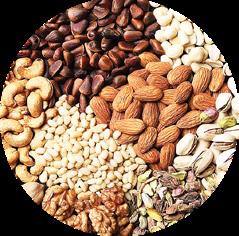
1 or more servings
Serving: 1/4 cup nuts or seeds
4 or more servings a day
Vegetables are your essential nutrient injection. Dark green leafy vegetables such as broccoli, collards, kale, mustard and turnip greens, chicory or bok choy are all good sources of important nutrients. They provide vitamin C, beta-carotene, riboflavin, iron, calcium, fibre and more. Extra beta-carotene comes from dark yellow and orange vegetables such as carrot, squash, sweet potatoes and pumpkin. Don’t be afraid to eat generous amounts. Load up your plate!
Serving sizes: 1 cup raw vegetables, 1/2 cup cooked vegetables


Within the four pillars of health lie the secrets to an enriched existence that form the foundation of holistic well-being.
Join the Whole Food Living community on Instagram and Facebook where we get to talk all things whole food plant based - from gut health to soil health and everything in between.


